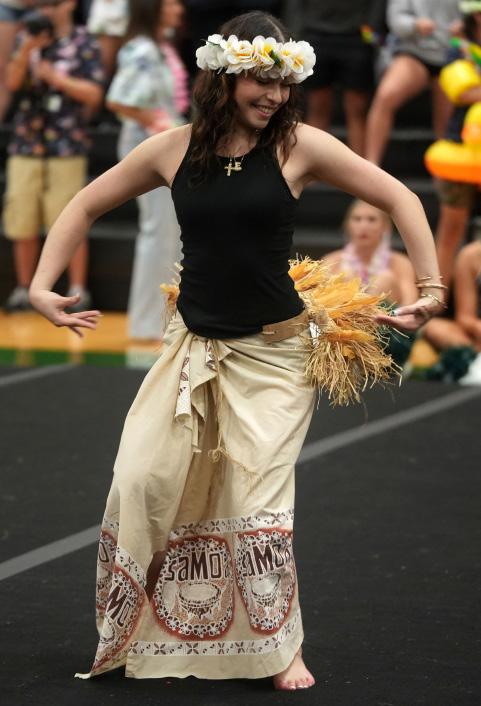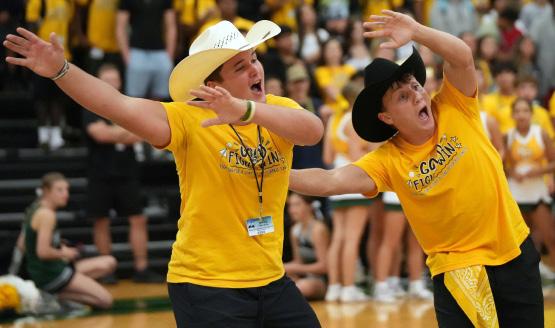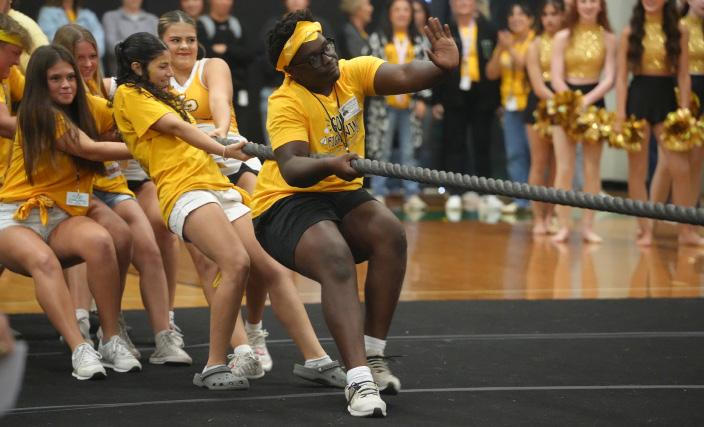
















By Tricia Darcy Editor-in-Chief
For new and returning students, walking into the school building looked different this year. On the first day of school, teachers and administrators welcomed students to the new school year, while also reminding them to turn off and put away cell phones. A phone would not be allowed in sight until the dismissal bell rang at 2:55 p.m.
For many students and teachers, the adjustments to the new policy were instantly noticeable. Students brought card games to fill the silence during lunch and pulled out coloring books to pass the time. In the classroom, students appeared more focused and the hallways were filled with engaging conversations.
“I’ve already seen kids talking to each other all day long,” biology teacher Kristen Lynam said. “The conversations were so much more in-depth and genuine. I’ve seen more interaction. Kids actually walking with their heads up, not down on their phones.”
Prior to the 2025-26 school year, the Texas Legislature passed House Bill 1481, a new state law prohibiting the use of personal communication devices (PCDs) in classrooms during the school day. The state law aims to reduce the number of distractions in a classroom setting.
The Humble ISD trustees approved the district-wide policy, which prohibits students from using cellphones, smartwatches, tablets, laptops, headphones and other PCDs during the school day. Since implementing the policy on Aug. 13, teachers have adjusted their teaching styles and students have adapted to the new challenges.
The district also adopted
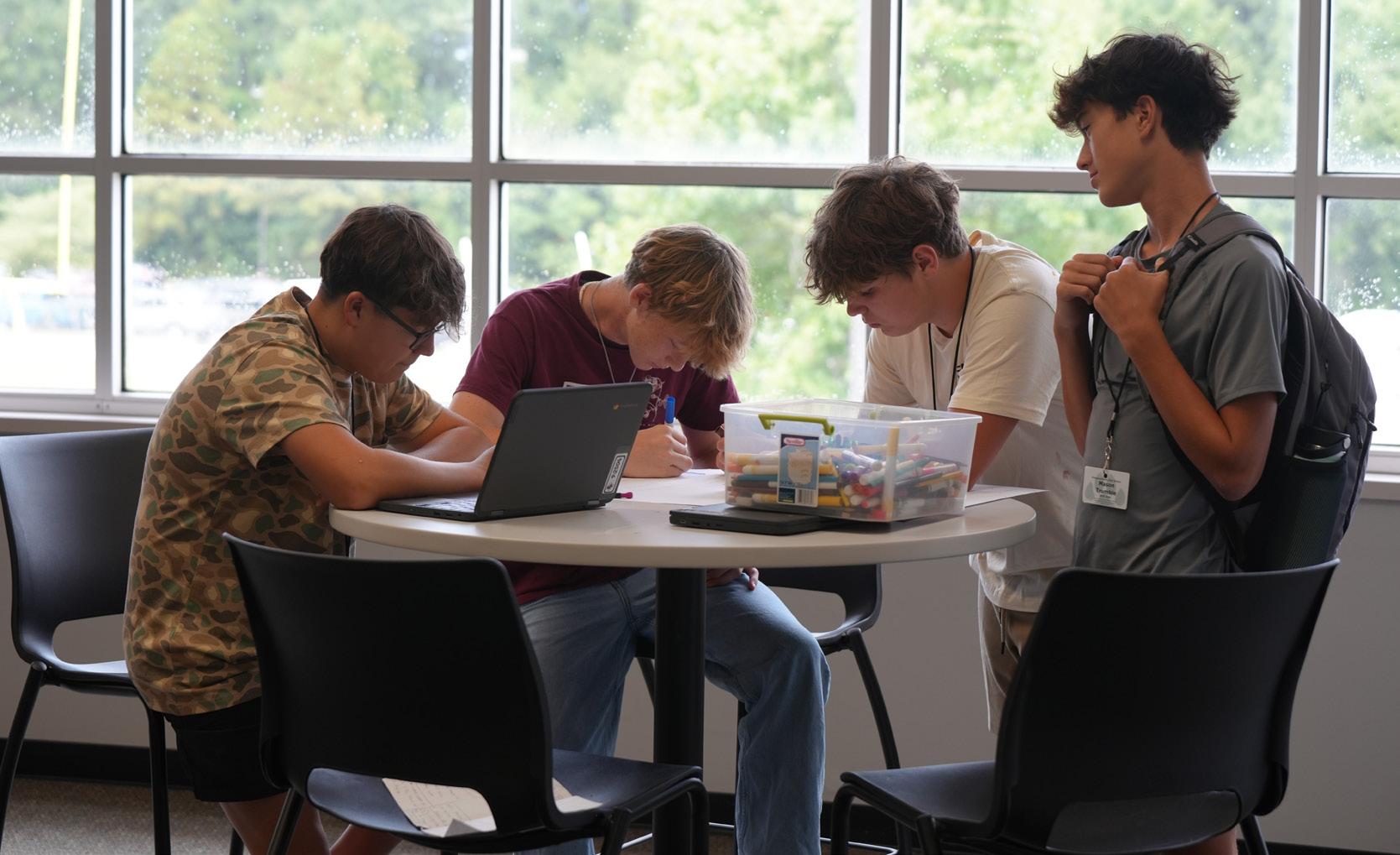
district-wide consequences. When a phone is seen by a staff member, the phone will be confiscated and taken to a house office. For the first offense, a student will be allowed to pick the phone up at 2:55 p.m. Any offense after the first time, a parent or guardian will have to come to Kingwood Park to pick it up.
While cell phones have been a focal point, students are also adjusting to life without their own laptops and headphones. Chromebooks are primarily used by all students in classes now, and accommodations for certain students are being worked towards.
“We plan on purchasing a lot of wired headphones,” Solomon said. “With the potential of, if you’re in a class with a Chromebook, you could plug the headphones in that are [the school’s] headphones and listen to music through that.”
The ban of headphones has been especially difficult for students who often wore them during school to focus.
“The first assignment that I was given today, I noticed that I’m already getting distracted by the person whispering over there and the person typing over there,” junior Bishop Scott said. “It’s just like my ADHD is going all over the place and my headphones trap it.”
The school is working with families whose students may need access to their phones for health reasons or accommodations their student has utilized in the past. A district form can be filled out for parents who believe their kids may qualify.
Throughout the first week of the new policy, students and teachers have worked to create necessary adjustments to the new policy, even with the mixed reactions it has received.
“Some advantages is you could start focusing on your work since you have nothing else to do,” senior Andres Campos said. “Some disadvantages are that if you have nothing to do, then you just sit there and stare.”
These devices may be carried by students, but they cannot be seen at any point from the time students enter the building until the final bell rings at 2:55 p.m.
Cell phones
Smart Watches
Tablets
Laptops
Headphones
Earbuds
Gaming Devices
Radios
Pagers
1st Offense: 1-hour detention. Student picks up device after school, same day.
2nd/3rd Offense. 3-hour detention. Parent/guardian picks up device after school, same day.
4th Offense. 1 day In-School Suspension. Parent/guardian picks up device after school, same day.
5th+ Offense. 2-5 days In-School Suspension. Parent/guardian picks up device after school, same day.
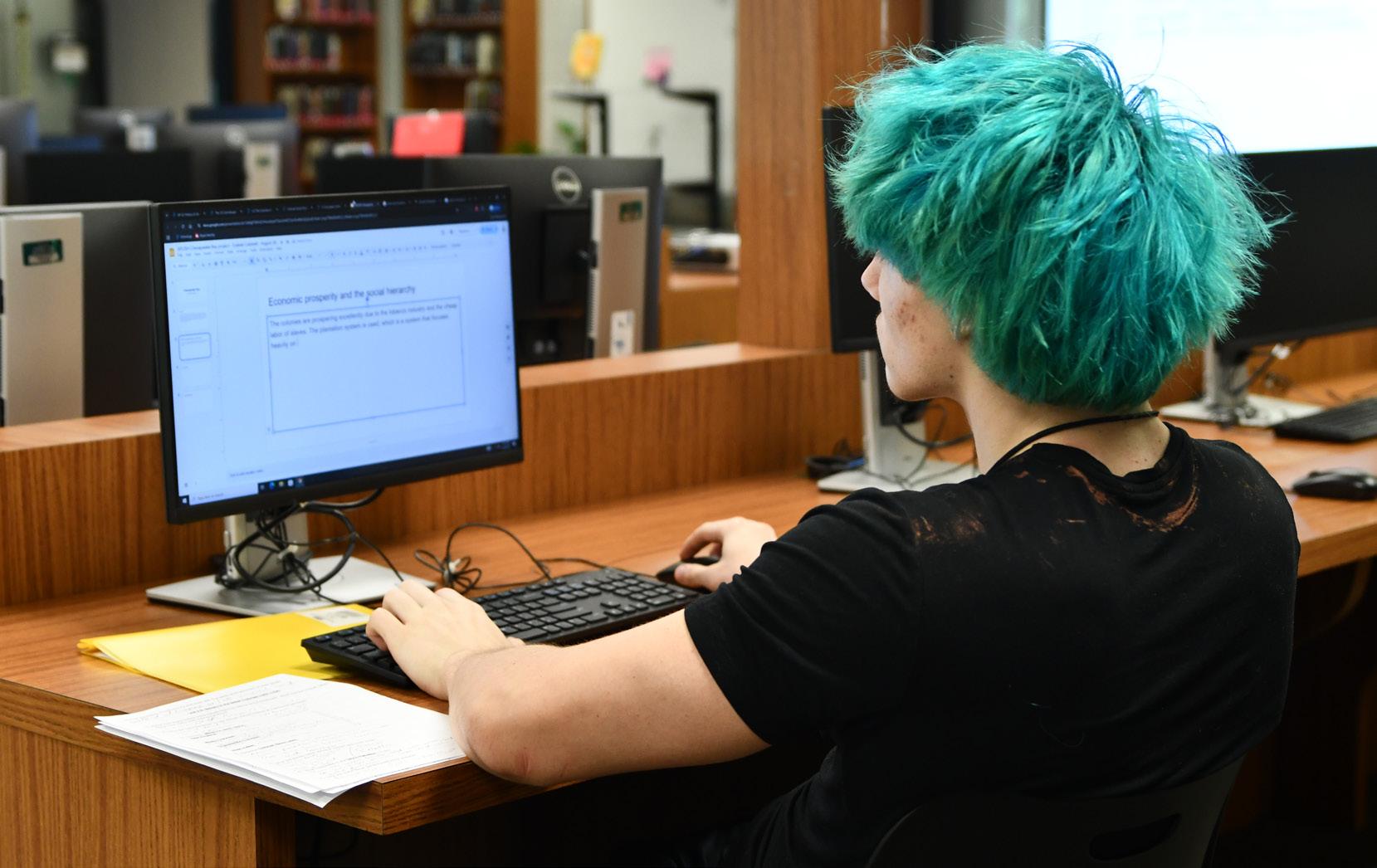
By Muhammad Adnan Staff Writer
When the Personal Communication Device (PCD) ban went into effect on campus this year, students quickly realized how much they relied on their laptops and phones to stay on top of their assignments during the school day. Now without those tools, many say they are struggling to finish their homework on campus, leading to late nights at home and less time for activities.
“It definitely saved me a bunch of time,” senior Max Raymond said. “I got a lot of work done in school, which gave me more time for golf and my job after school.”
Other students agree that losing the ability to use their own devices has taken away a valuable block of productivity.
“Getting my work done during school gave me time for cross country, church activities, my job, and hanging out with my friends,” senior Will Burningham said.
With personal devices off the table, the library has become a
natural alternative. Librarian Jessica Castille said she has already seen more students coming in during the mornings and throughout the day.
“Before the PCD ban, we would have about 100 students during flex hour and nearly 1,000 students a month,” Castille said.
“Now, we’ve already seen an increase in students using the desktops, printing and checking out books. If Flex Hour returns, I expect those numbers to double.”
However, while students are making the shift, they say the technology isn’t always keeping up. Burningham said that using the current desktops at the library can be a frustrating experience.
“The computers are really slow,” Burningham said. “Even if you want to get work done, it takes way too long.”
Castille acknowledged that some of the library desktops are outdated and won’t support Windows 11 in the future, but she said improvements are already being planned.
“We do have another set of Chromebook carts being added
to the library,” Castille said. “The Chromebooks will give students more options for reliable devices, and we’re doing the best we can with what we have.”
Raymond said he would like to see Humble ISD offer personal laptops to students, similar to what other districts provide.
“One of my friends in Cy-Fair ISD gets a personal computer from his district to bring home and use at school,” Raymond said. “I think that would make it easier for us to stay on top of our work here too.”
For students, the change is about more than just convenience — it’s about flexibility. As sports, jobs, and after school commitments fill students’ schedules, many are hoping that better access to technology during the day will help them reclaim the balance they lost when the PCD ban began.
“Working in school was really important for me as I don’t have much time after school due to my job and other activities,” Raymond said.
By Eleanor Durand Staff Writer
Students in choir recently participated in All-State Choir pre-Area auditions on Saturday, Sept. 13. The event took place at Summer Creek High School. Choir members were required to learn four pieces of music for their audition.
Fifteen students advanced with five earning chairs.
“This will be my fourth year participating in region choir,” senior Amara Amadi said, “and it’s always my favorite part of the year. I look forward to it the most because I love learning about new music, composers, languages and cultures. The worst part is the pressure and anxiety that comes with it; but when the audition is over and the results come out, it is an extremely rewarding experience.”
The process goes as follows: Each person is required to learn four different pieces of music. On audition day, the members wait for their voice part (soprano, alto, tenor, bass) to be called, and they get pulled into their voice room that corresponds to their part. The staff informs everyone of the cuts in the music and are told to sing it twice.
When they’re done, they wait for their number to be called.
“Region for me was very scary, considering it was my first time,” senior Ethan Durand said. “I really didn’t know what to expect, and the waiting made the anxiety drag on even more.”
The students who advanced were: Madelyn Haynes (first chair), Amadi (second chair), Evangeline Garrett (3rd chair), Riley Fitch (4th chair), Juliette Norman (5th chair), Durand, Skylee Hartman, Bella Barrett, Linden Brom, Reagan Miller, Cannon Streb, Johnathan Kanak, Jesse Ramirez, Liam Shynett and Adrian Gutierrez.
The
halls used to be packed during the one-hour lunch break as students had the freedom to eat in the halls, visit classrooms for tutoring, attend club meetings and more.
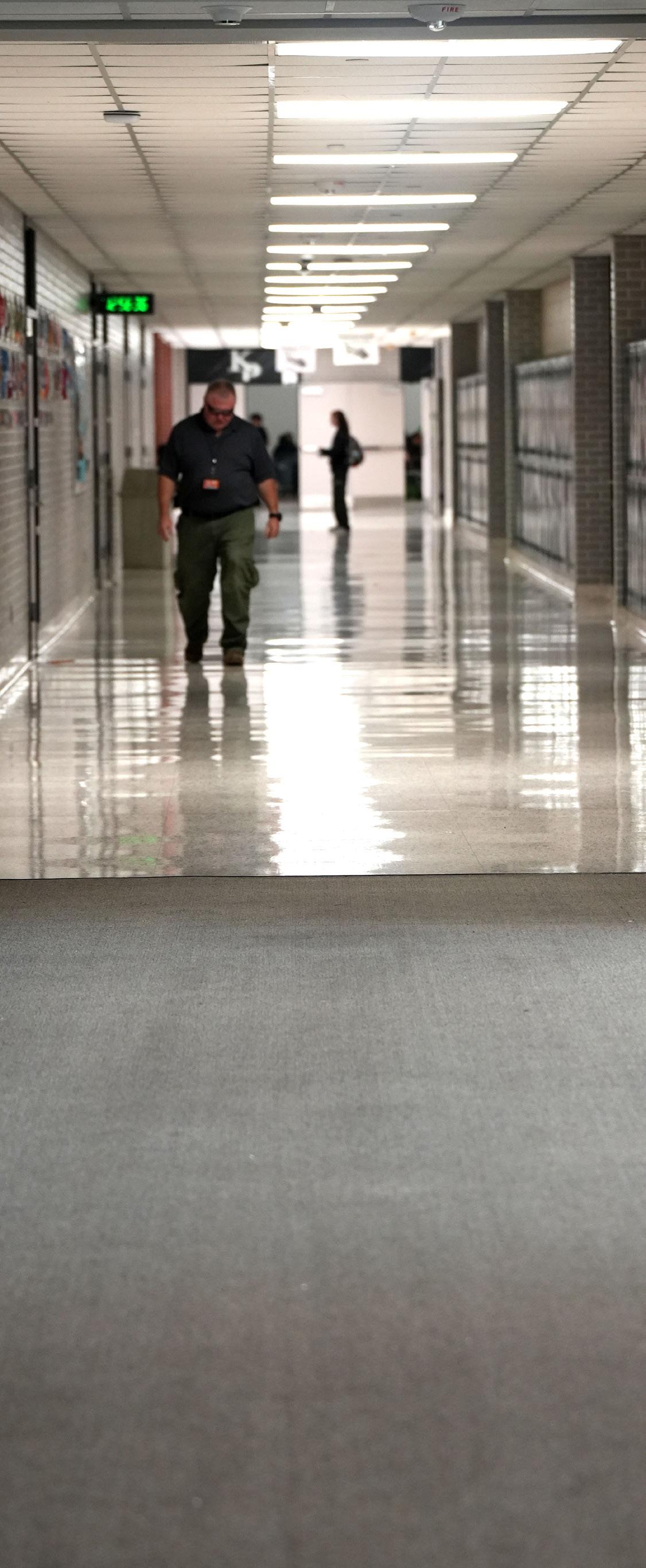
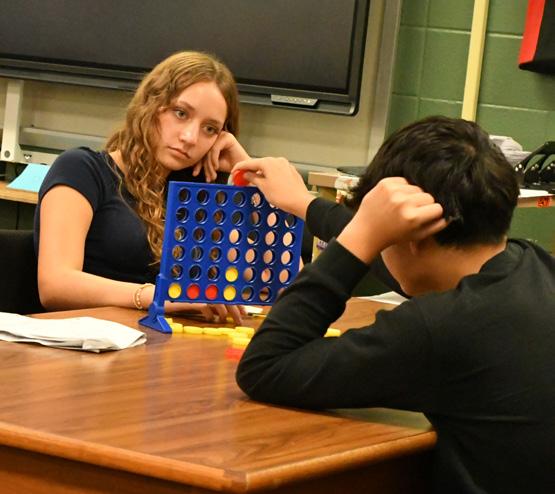
By Sydney Ortiz Editor-in-Chief
The hour-long lunch break that students loved for the past seven years is not coming back soon.
Implemented in 2018, Flex Hour allowed students 60 minutes in the middle of their school days to attend tutoring, make up tests, hold club meetings, socialize with their peers and eat lunch.
Kingwood High School, the only other school in Humble ISD with a Flex Hour, is bringing it back on Sept. 23. Kingwood Park principal Wes Solomon said KPHS will not change its current schedule until at least the first nine weeks ends.
“I’ll take a little heat for going slower to roll it out right,” Solomon said.
“
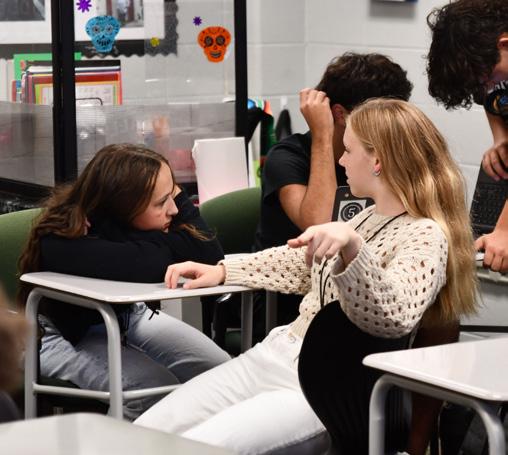
are spread across four lunch shifts, which are each 30 minutes. Because the class is so much longer each day, 30 minutes is supposed to be set aside for study hall or a once-a-week advisory lesson developed by the school counselors.
The change has been difficult for students. Junior Maya Fritz juggles three jobs outside of school. When she missed three days of school for a HOSA leadership conference in August, she struggled to catch up.
“ I think there are some good things about [Flex Hour]. But I also think in the last couple years, it got to a point where for the majority of our student body it’s just a social hour for 60 minutes.
Wes Solomon, principal
“Because I think there’s some really good things about it. But I also think in the last couple years, it got to a point where for the majority of our student body it’s just a social hour for 60 minutes.”
Instead of flex hour for the first six weeks, students have spent 99 minutes in their fifth period class. Every other class period during the day is between 48-51 minutes.
The 99 minutes of fifth period
“I missed three tests that I had to make up,” Fritz said. “While some of my teachers were really lenient and I was able to complete them in the class period, I had to take off work for a couple of days to make up those tests.”
For the first nine weeks, teachers were required to offer tutoring one day a week before school and one day a week after school.
The 30-minute sessions were not conducive for students to make up tests however. And sometimes the days and times offered did not work for the students.
Junior Courtney Scott, a state medalist in swim has felt the absence of flex hour. She spends her mornings at school swim practice and her afternoons at club practice.
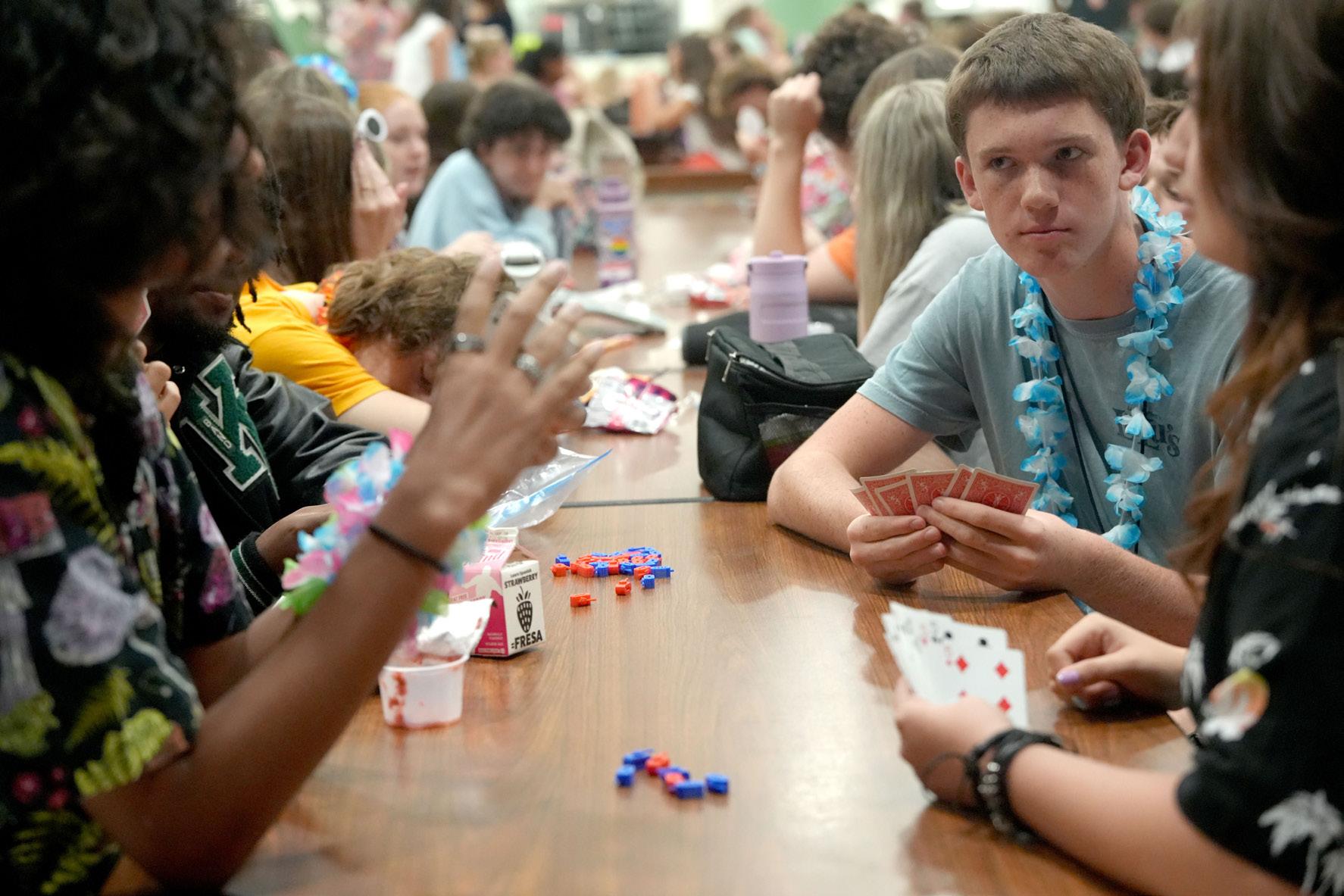
“I have not been able to [go to tutoring] because of practice before school and then practice after school,” Scott said. “With those practices being mandatory, I’m not allowed to miss so I can’t come to tutoring at all. I feel like I’m falling behind in my classes.”
To help the testing situation on Sept. 16, the administration opened up a testing center at 3 p.m. on Tuesdays and Thursdays, giving kids a one-hour window to take tests.
On the old Flex Hour schedule, the testing center was open everyday except for Tuesdays.
Tutoring was also available with one teacher or another almost daily in any subject. It worked well for kids who were in sports or who had after school jobs and commitments.
“My favorite parts of Flex Hour are definitely the times you get to go with teachers and do your study hour,” senior Michael Segura said. “Tutoring is a big part of my success in school, so without flex, I really have to make time after school and before school. But with extracurricular activities, it’s kind
of hard to do that.”
Solomon said he is trying to fix that problem for students. He and the administration have researched alternative ideas to Flex Hour.
“So could we do an A lunch, a B lunch, a C lunch,” Solomon said, “and then D lunch everybody’s in their fifth period class? But if they need to go to tutoring, they could go to tutoring during that period?”
The uncertainty leaves students who run clubs and organizations still trying to figure out how to navigate meeting times and how to recruit new members.
Attendance at after school meetings is lower than it was during Flex Hour.
“It’s very hard [to run organizations] because a lot of people can’t come after school due to other things and then doing it before school people have sports,” said senior Marisa Chinen, who is an officer in three clubs, including president of National Honor Society. “It’s hard to find a medium for everybody.”
Chinen also said juniors and
seniors who have late arrival or early release are less willing to show up before school or return after at 2:55 p.m. for meetings.
The bell schedule currently utilized by Kingwood Park is similar to those shared by the much larger schools in the district whose enrollment numbers (from TEA’s 2024 federal report card) make four lunches necessary – Summer Creek (3,595 students), Atascocita (3,822 students) and Humble (2,862).
Kingwood Park’s enrollment is 1,946.
Kingwood High School has almost 3,000 students, but will return to what they call “Mustang Hour.”
Solomon understands Kingwood Park students are frustrated with the change and said he is still trying to work out a system that will work best for the campus.
He said safety is a main issue keeping Flex Hour from returning.
“The big thing with safety right now that I’m trying to wrap my head around… is we can’t account for kids during the hour,” Solomon said.
He explained that in past years with PCDs, if a child needed to be picked up their parents would call or text them. But with phones banned by the new state law, it is hard to get messages to a student or find a kid in an emergency.
“I’ve got to think what’s best for our kids and what I’m willing to allow or tolerate when I go to sleep at night,” Solomon said.
Many students are holding out hope that Flex Hour returns when classes resume after Fall Break on Oct. 20. Aside from tutoring and club involvement, they miss seeing their friends. Students rarely see any of their friends who are not in their classes anymore.
“I think Flex Hour is important because, first of all, you get to have time with your friends,” Segura said. “I know a lot of people don’t think that’s very important, but it is. It’s also a good time to have a mental break throughout the day, especially with having AP classes and whatnot. I think that’s a big part of it.”

Longtime auto collision teacher Jeff Wilson, his wife Amber and son Shiloh drowned in the Central Texas floods in July.
By Sydney Ortiz Editor-in-Chief
Auto collision teacher Jeff Wilson and his wife Amber stood right outside the Kingwood Park dugout on May 1. Their 12-year-old son Shiloh was inside wearing his baseball helmet and giving a pep talk to senior ace Aden Murray, whose arm was hurting in the team’s first-round playoff game against Brenham.
“I don’t know if I’ll be able to finish this inning,” Murray told Shiloh, who was the team’s bat boy.
Shiloh wasn’t worried. “I guarantee you’ll get out of this inning in less than four pitches,” he told Murray.
Four pitches later, Murray walked off the mound and looked straight at Shiloh, who was jumping up and down. “I told you so!” Shiloh shouted proudly.
Murray knows Shiloh’s ear-toear grin during that game will never be forgotten. Murray can also still hear Jeff and Amber shouting for every player on the team, arguably louder than any other parents in the stands.
Jeff, Amber and Shiloh Wilson died in the flash floods by the Guadalupe River on July 4. They had been camping near Kerrville for a youth rodeo event.
Shiloh, the 2024 Rookie Junior World Champion Rough Stock Saddle Bronc Champion, mostly talked baseball in the Kingwood Park dugout, but he also talked about his rodeo days once in a while.
“It hits harder to me, because I promised Shiloh I’d make time to come watch him rodeo this summer,” Murray said. “Knowing he’s gone and that he and his family are in heaven right now, it’s hard to realize I’ll never be able to
watch Shiloh ride. It sucks knowing that such a beautiful family has been taken away.”
Active members of Kingwood
The void of the Wilson three will be felt throughout the Kingwood community. Amber worked 27 years at Insperity, a company in Kingwood that provides human resources and other services to small and medium-sized businesses. Shiloh was a rising seventh grader at Creekwood Middle School.
At the final faculty meeting of the past school year in May, Wilson was recognized with teacher Kimberly Ackerman for 30 years in the district. The two became close friends over the years as they taught together at Humble High School and Kingwood Park. That day as they received their 30-year service pins, they joked with the faculty and hugged.
“If I’d known that was my last hug, I would have hugged him a little harder,” Ackerman said.
Wilson added joy, humor at work
Wilson was a fixture in the back row of the faculty meetings with his closest colleagues.
Former principal Lisa Drabing remembers the blue-collar comedy show Wilson performed with agriculture teacher Kevin McCarty one year during in-service meetings. Wilson and McCarty had the entire staff laughing.
“He just had this big personality and the ability to make people laugh,” Drabing said.
McCarty and Wilson first formed their friendship in 2001 as teachers at Humble High School. When Kingwood Park opened in 2007, they both moved to the new school to build their own programs. Wilson spent so much time in the
agriculture classroom helping McCarty, students often thought he was an ag teacher too.
The two also found themselves in a little trouble with Kingwood Park’s first principal Larry Cooper when they were supposed to turn in an evaluation. They got a copy of one from a fellow colleague. Wilson and McCarty then both forgot to replace their colleague’s name with their own names when they turned it in. Cooper made sure the entire faculty knew what they had done.
“We were always horsing around and making jokes,” McCarty said.
Jokes often filled Wilson’s classroom as well. Students in room 1722 often started their class hearing funny stories from Wilson about his life – from his own days as a bull rider and world class saddle bronc champion to his stories about raising Shiloh.
Wilson made sure his classroom was never silent. He’d walk around his room helping students and joking with them. Students would often hear rock and country music coming from his office.
Students found a home in Wilson’s classroom
Murray first signed up for what he thought would be an easy elective as a freshman. Soon, he never wanted to leave the safe haven Wilson created in Room 1722. Murray, like many others, signed up for Wilson’s classes every year – sometimes having Wilson more than once a day. He became a father figure to Murray, just like he had already become for so many others.
“He was never there just to get the paycheck,” said Murray, who graduated in May and now works as an electrician. “He wanted to have a big impact on every single kid that was in his class. He wanted to make a big impact in their lives.”
Wilson did not only teach automotive lessons, but also life lessons. He taught his students not to judge, and showed them what it was to be a good friend.
“He was always willing to help you,” Drabing said. “He never said no. He was just that kind of a
Amber, Shiloh and Jeff Wilson talk to David Bender during an event held in Jeff Wilson’s classroom on Dec. 8, 2021. Bender was a student of Jeff Wilson’s at Humble High School, and Bender’s children took Wilson’s classes at Kingwood Park. “He was more than a teacher, kind of like an uncle to me,” said David’s daughter Jordan, who graduated in 2024. “He never wanted to do anything without (Shiloh and Amber), that’s for sure. He was always there for Shiloh at his rodeo events or baseball games. And I only met Amber a few times, but she was the sweetest woman I’ve ever met.” Photo by Alicyn Logue.
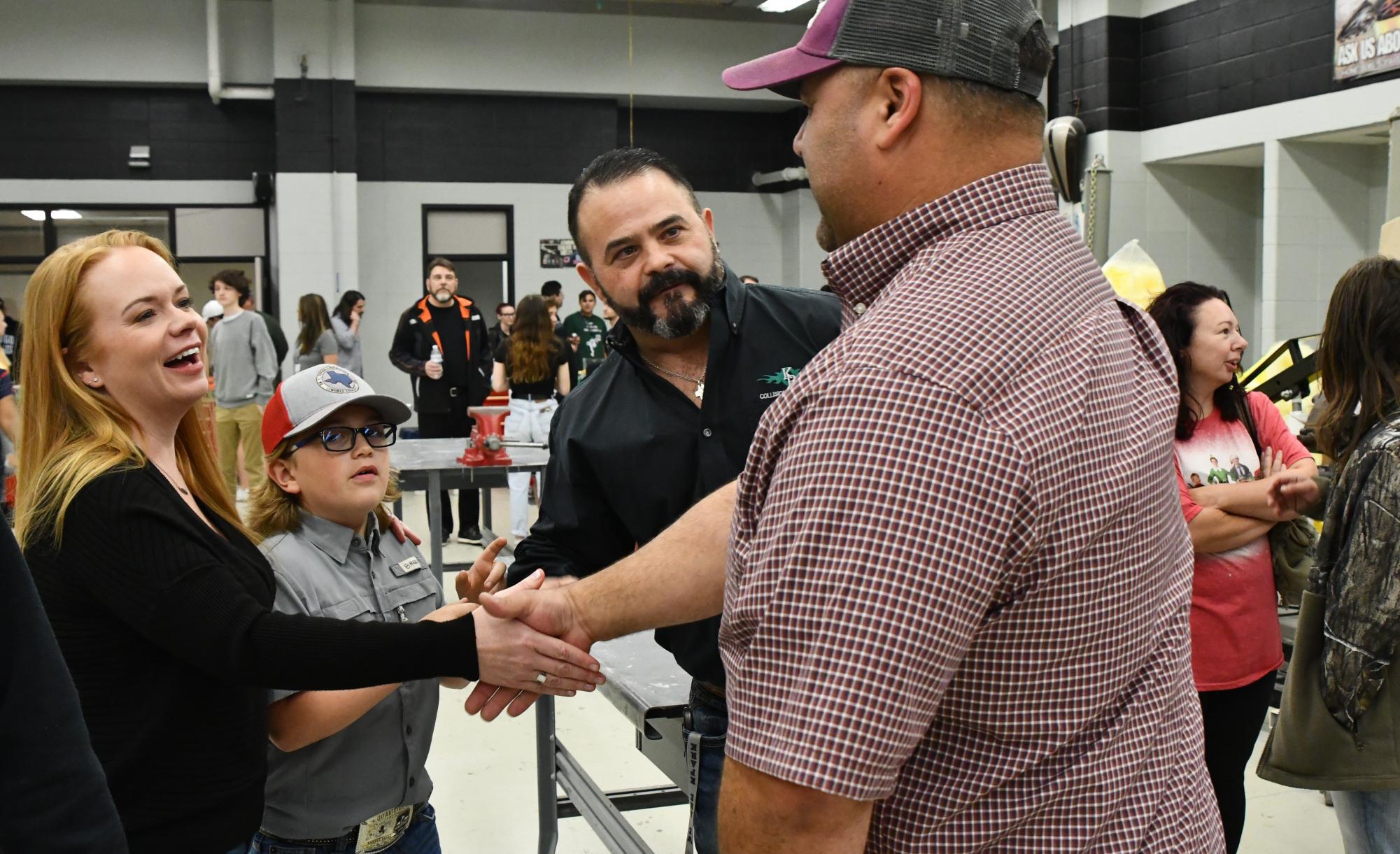
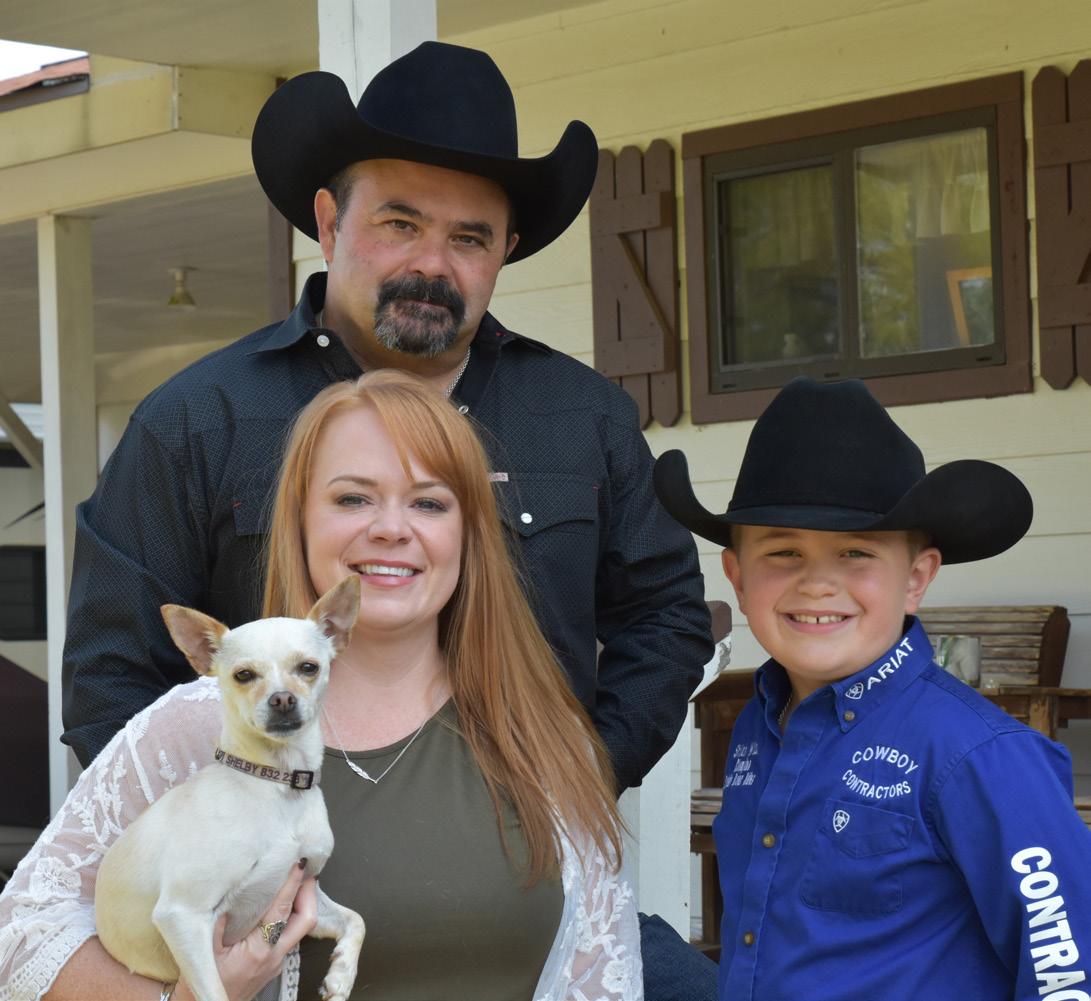
person. I knew it was a friendship that I could always count on.”
If Wilson’s colleagues ever needed help, especially with their cars, they knew who to call. Wilson and his students worked on two of architecture teacher Missi Taylor’s cars.
Taylor would buy the materials
needed and lunch for the students who worked on it, and Wilson’s classes would start fixing. During big projects, he’d walk around the room telling his students safety reminders, making kids laugh even when using a stern tone. “Don’t be stupid and burn your hand,” he’d remind
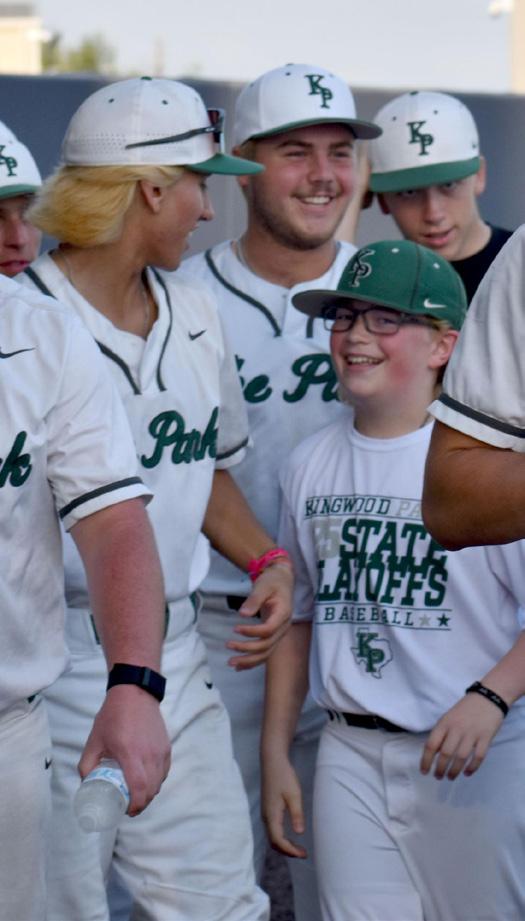
those welding. Wearing the safety gear when painting was key “so you don’t get cancer,” he’d remind them.
“The kids knew that was a home out there for them and that it was a safe place,” Drabing said. “He
WILSON, continued on page 9
By Leonardo Peña Staff Photographer
To junior Austin Cater, fishing was just a way to hangout with his friends
“Once COVID happened, me and a couple buddies, we would just go to the pond and just try to catch as many fish as we could in a day,” Cater said.
Over time, his love for fishing grew. Today, he spends his free time fishing at local ponds and competing against his friends. Despite being in school, he still finds time to go fishing weekly.
“I go every weekend,” Cater said. “I try to go at least once a week. Most of the time I go three to four times a week. I can get it done for something I love.”
He’s a part of the Kingwood Bass Fishing Team, which competes in tournaments hosted by the Texas High School Bass Association
“The people and friends I've made throughout the club have been people who I will cherish for a long time,” Cater said.
The club is more than just a meeting place for fishermen. It also helps prepare the students for their upcoming tournaments.
“The school has helped us by giving us off Fridays before the tournaments, to pre-fish and get everything we need to know about that lake and that specific day,” Cater said.


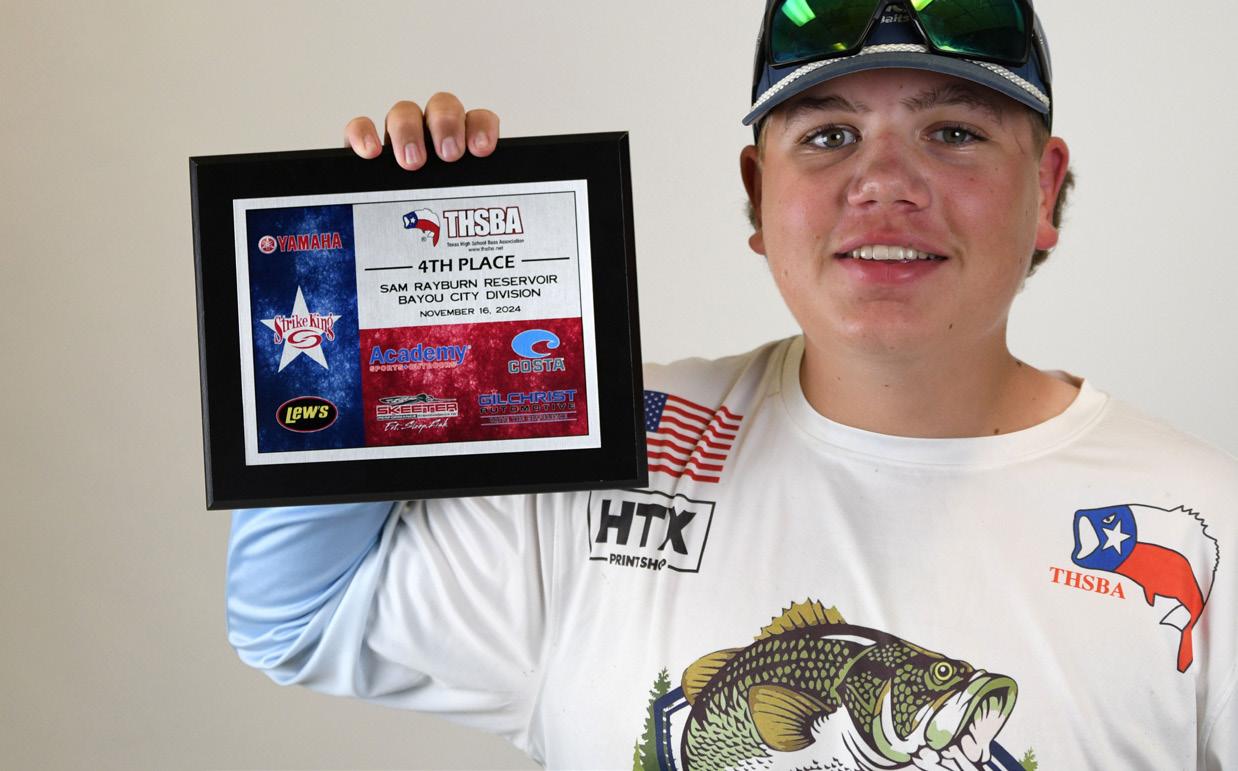
Outside of the club, he also fishes competitively. Starting the season last year, he was ready to compete.
“So last year in my first two tournaments, I came in super confident in the season and I bombed,” Cater said. “I didn't catch any fish the first two tournaments and I really thought this is not for me.”
Despite not catching anything in those tournaments, he still had the confidence to try again. The next opportunity he had was the Rayburn Fishing Tournament, which consisted of people from all around the region.
“The very next tournament at
Rayburn, I go around and get fourth place out of 220 boats, so it really spun my entire tournament series around,” Cater said.
Fishing is not easy and the supplies cost money. For Cater, he advised others who love the sport to get involved and use whatever they can find or afford.
“People are going to always have nicer stuff than you,” he said. “You just got to go work harder, and appreciate more of what you have than what they have.”
By Amita Ramcharan Special Contributor
Peyton Chesney never wanted to do band let alone flute.
“I wasn't challenged enough in 7th grade, so I considered quitting,” Chesney said.
However, she then met clinician Cary Faulkner.
“She did master classes for us in seventh and eighth grade and she just pulled us out of class to work on, like solos, region music," Chesney said. "Re-
ally, anything we needed help with. She was a great help.”
This teacher made Chesney feel seen, heard and, most of all, like she was improving more than she ever had.
“She's always been really supportive of me,” Chesney said.
Chesney’s eighth grade year really turned out to be one of the best years for her. Not only was she on Wind Ensemble, the highest band at West Lake, she also made the varsity marching band at Kingwood Park.
“Mrs. Faulkner reached out to me before my freshman year started and asked me if I had gotten my music for this school year, she also asked me what band I was in and congratulated me when I told her I made varsity,” Chesney said.
As a freshman now, Chesney is excited, yet scared to be on the varsity marching band with classes getting harder and band practice being long and grueling.
“I am ready for the challenge," she said.

‘He was so proud of that little guy’
had their best interests at heart, and he was going to provide them with an opportunity once they left Kingwood Park High School –something they could be successful at and that they could be employable.”
Absence already felt at Kingwood Park
Taylor reported back to her classroom, which is next door to 1722, on July 21. During the summer, tears surfaced each time she remembered he wasn’t returning.
“I don’t really want to walk past the door, but I have to,” Taylor said through tears on July 23. “I find myself looking in the window, looking for him. And I know he’s not there.”
The entire wing of the building will be different without Wilson’s presence. Taylor spoke to Shiloh and Jeff just two weeks into June. They caught up with each other and spoke about their summer plans, right outside their classrooms.
McCarty will never forget playing catch with Shiloh in the hall when he was 5 years old. And
Drabing remembers Wilson bringing baby Shiloh up to her office to visit on work days.
Since the school year started, longterm subs have filled his role in the classroom.
“He was so proud of that little guy,” Drabing said. “It was just fun watching him be a dad. He loved it.”
Ackerman said it felt as though she knew Shiloh before he was even born because Jeff talked nonstop about the little boy. His face would light up. He was 43 years old at the time, and he was also nervous.
“I’m going to be an old man when he graduates,” Wilson told Ackerman.
“You’re going to be a great father,” she’d remind him. “It’s going to change your life.”
After Shiloh was born, Wilson continued to share frequent stories about his son. The pride was evident every time he mentioned his son’s name.
“Every time he’d talk about Shiloh, I’d say, ‘It changed your life, didn’t it?’” Ackerman said. “And he’d say, ‘You betcha!’”
By Cameron Minatrea Sports Editor
When Blake Hartman sat his head on the desk again, his teacher knew that once again he was going to sleep and missing another lesson in her class. Even though he had A’s and B’s across the board, he couldn’t seem to focus on what was being taught. But while everyone around him saw a kid with no care for learning, Hartman closed his eyes and dreamt of bigger things.
“I was really good at school, but I wasn’t a good student,” Hartman said. “I could fall asleep and still get an A. I would get several calls home saying I was sleeping again.”
A member of the first graduating class at Kingwood Park in 2010, Captain Blake Hartman returned to campus to speak to JROTC, FFA and Animal Science classes about his life after high school and the achievements of his career.
Hartman hoped to inspire kids that may be unsure of their future to not only pursue their dreams, but to also be hardworking in their future endeavors. He used his story as an example.
“It’s okay to not know what you want to do with your life, it’s perfectly fine,” Hartman said. “But always be thinking about what you’re passionate about.”
Hartman’s passion led him to the Air Force after high school, where he spent 15 years in the military. He travelled globally,

working different communications and technology jobs. In 2021, he joined the United States Space Force, where his current occupation is the Director of Operations at the Cyberspace Squadron.
One thing that Hartman reflected on was returning to his old school, but now from a new perspective. The same teacher that taught him 15 years ago, still teaches FFA today.
“I had him junior year and senior year of high school,” FFA Teacher Genevieve Ubnoskye said. “He was very defiant, kinda like his way or the highway, but once he was engaged he was awesome. He was like a rockstar on any team we put him on.”
Whether current students are in the same programs Hartman took, his advice targets everyone. Hartman hopes that he can inspire students to pursue what they love most.
“Those types of guest speakers, it is always good to have them,” junior Selvin Blanco said. “They show and make you reflect on yourself and what you want in life.”
By Sydney Ortiz Editor-in-Chief
History teacher Amy Balke struggled to stand on her own. She held onto different players as she attempted to coach the softball team through the third round of the 2017 UIL playoffs.
A week earlier, Balke lost most of the feeling in her legs and she had no idea why.
“I was walking around like a toddler,” Balke said. “It was as if [my foot was asleep] in both legs. I had a hard time walking, and as the week went on it got worse.”
At 27 years old, Balke had just been named Kingwood Park Teacher of the Year. She was busy with teaching and coaching, and she didn’t think much of the symptoms that were making walking a challenge. She was more focused on her role as the assistant softball coach. The team was right in the middle of the program’s deepest playoff run at the time.
Balke wasn’t panicking, but those close to her were growing more and more concerned. There were no quick answers though. It took numerous doctor visits, more health scares and two years of worry until Balke was officially diagnosed with multiple sclerosis, a rare disease that causes the breakdown of the myelin sheath, which is the protective layers of nerves.
The first health scare
While Balke was uncomfortable but not concerned in 2017, her mom was worried.
LeeAnn Balke reached out to her daughter’s childhood best friend Lindsey Humphries, who was a nurse in the neuro unit at Houston Methodist hospital. LeeAnn wanted to see if Humphries could help evaluate the pain.
The next day Humphries went
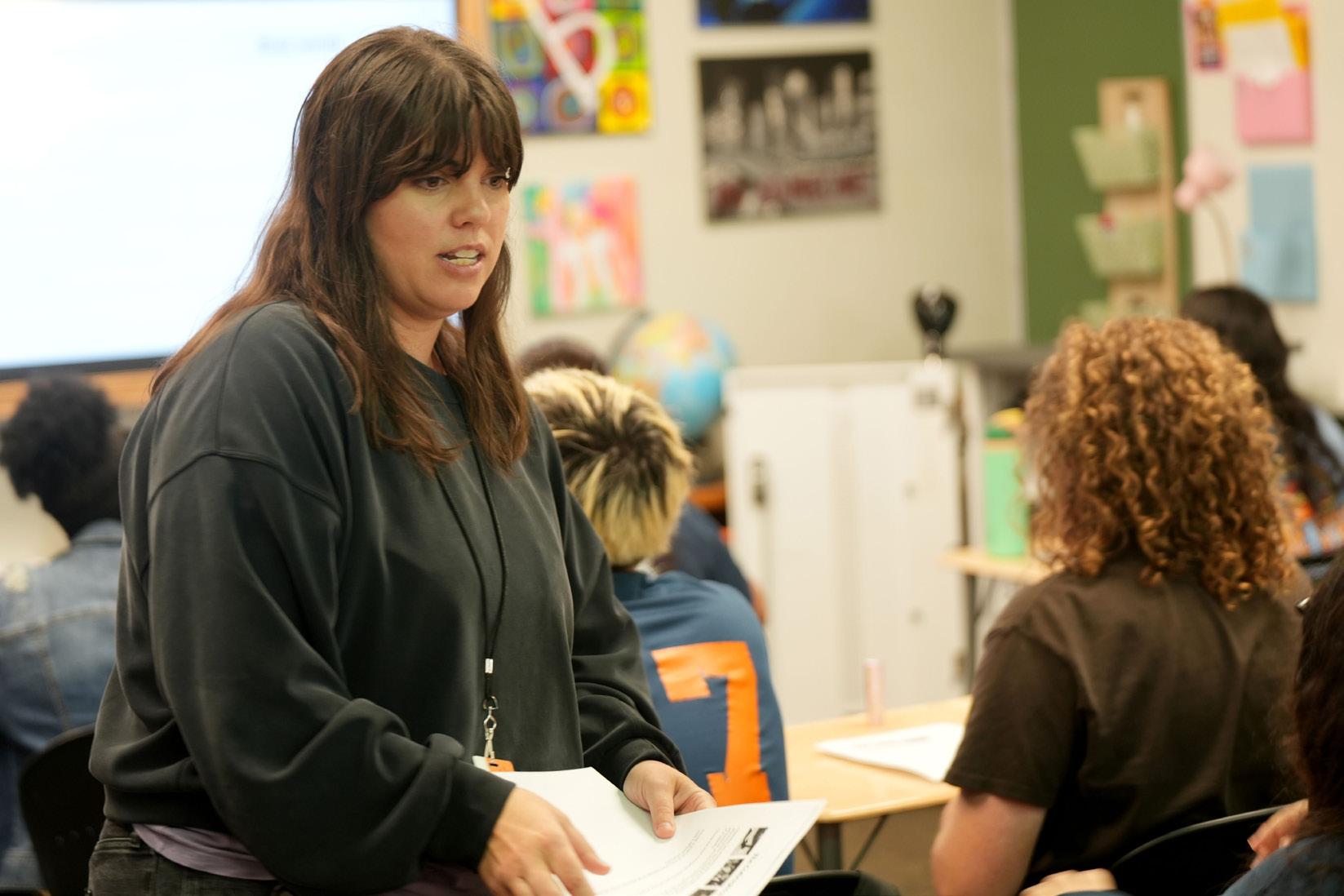
with LeeAnn to support Balke and the softball team. She saw Balke’s leg pain firsthand.
“I got to the game and quickly knew something was wrong,” Humphries said. “I mean, it wasn’t typical. It wasn’t a back issue, something was up.”
After the win against Crosby, marking the softball team’s furthest playoff run in school history, Humphries insisted her friend go to the hospital.
Balke listened and admitted herself into Houston Methodist with the help of Humphries. Balke spent the week hospitalized.
“It was just really scary at first because we didn’t know what it was,” Balke said. “And they won’t diagnose [MS] until you have more than one lesion.”
The lesion the doctors found in 2017 was in her spinal cord, which caused the problems in her legs.
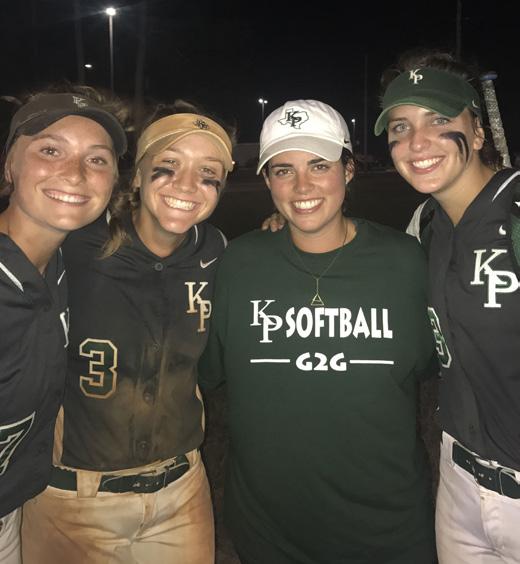
History teacher Amy Balke celebrates with softball players during the 2017 playoffs. She was an assistant coach for the team at the time and was dealing with numbness in her legs that often forced her to lean on players to get around. Photo courtesy of Amy Balke.
The diagnosis
Balke felt fine for about two years. In 2019, panic struck.
“I remember I was in class and I got super fatigued from typing,”
Balke said. “I was like, ‘Am I having a stroke?’ I was freaking out.”
Balke went to the hospital, and the doctors found a second lesion.
During that trip she was officially diagnosed with MS.
Balke’s first lesion in 2017 was pretty severe, making the diagnosis in 2019 easy for doctors. They immediately started working to get her lesions under control.
Less than 200,000 Americans are diagnosed with MS each year. Doctors are still searching for a cure to MS, but current medicines and treatments help MS patients with the symptoms. MS patients can lose their ability to walk and some can lose their ability to move all together.
“When she got the diagnosis, like from the friend POV, obviously it’s very scary,” said Talya Bean, a longtime friend and colleague. “But it was also kind of a little bit of a relief for her, because we just
didn’t know what was happening to her every year.”
With the diagnosis, the doctors were able to prescribe her medicines to manage her MS symptoms. Balke also had to reevaluate her lifestyle. Stress and heat are some of the things that cause her MS symptoms to flare-up.
“Being out on the softball field every day until 6 p.m. and then being the pitching and catching coach and calling pitches in playoff games wasn’t ideal for me,” Balke said.
Balke tried to stick with coaching. But by early 2020, she decided a break from coaching would be best for her health.
Balke had been around softball teams her whole life. She started playing t-ball as early as possible and was a bullpen catcher for the University of Texas softball team all through college. Her first job after college was a head softball coaching job near Fort Worth.
Stepping away from softball was tough.
Balke remained a history teacher on campus and a common face around the softball field.
She still attends as many games as she can, and for a few seasons she drove the team bus to away games.
“I try to do stuff when I can to stay with them, but it’s definitely not the same,” Balke said.
Since 2019, Balke’s lesions have remained stable with the help of
the medications.
Her biggest struggle through the MS diagnosis has been getting her medicines covered by insurance companies.
“Dealing with insurance for specialized medication is a nightmare,” Balke said. “It takes a village every time.”
Balke’s personal battles with MS are hardly detectable at school.
“I don’t think any of the kids really know unless she comes right out and tells them,” Bean said.
Her AP Psychology class is a favorite among juniors and seniors because of her lecture style and projects. In the past three years, her AP testers have consistently had an 80% passing rate.
While her days can be stressful because of insurance battles or MS flare-ups, she tries to not carry that over into her classroom. She knows students are battling their own struggles on a regular basis. After everything, she knows sometimes even a small gesture can make a big difference.
And unlike back in 2017 when she just tried to push through her own pain, she now does not hesitate to ask for assistance when it becomes too much..
“If I come into your life, I want to be a positive impact, a good part of your day not a rough part,” Balke said. “I’m just a pretty optimistic person. I feel like I roll with the punches pretty well. Then there are times where it feels like a lot, but I’m better about understanding my limits. Not afraid to ask for help when I need it.”

By Paisley Thomas Opinions Editor
Sophomores Jamen Hicks and Adilyn Osbourn had the opportunity to perform with Drum Corps International for the summer. They practiced and rehearsed for hours until they went on tour, where they then rehearsed and put on a collaborative show with different groups of people from all over the world.
“Man, it was super super cool for me,” Hicks said. “It was such a big opportunity to be able to do it. It was just a big moment for me. There was an opening and they were like, do you want to fill it? And I was like, of course. I was nervous. I was really scared I was going to get cut, because I didn't think I was going to be good enough, but I was good enough.”

band nerds.”
Bre Osbourn has now had both of her kids be a part of Drum Corps International, and she herself has been able to be an instructor at the Lucas Oil Stadium in Indianapolis where the championships are normally held. Ean Osbourn was part of the program in 2023. Adilyn Osbourn marched this year in color guard.

“What you do is, of course, you make a show but what you really do is just build a bond with people, and you really carry that bond until the end of the season” Adilyn Osbourn said. “It's really fun. It's definitely an experience. No one else is experiencing this with you. You know? It's been amazing.”
Drum corps travels to competitions all over the country and have people come from all over the world to collaborate and learn a certain style in order to compete in a certain group. There are different groups that you can audition for at various different levels. During the fall there are mini camps as well as during spring break. Then as soon as the summer hits they are off touring.
“They marched at World Championships and Lucas Oil Stadium, which is amazing and a huge experience,” band director Bre Osbourn said. “And it's a really, really good college scholarship opportunity for all the kids that participate in it. It's basically the Super Bowl for
The students in Drum Corps are very close knit and learn to depend on each other. They spend their days staying at different colleges and rehearsing for 14 hours a day leading up to the performance. The students are having to learn very difficult pieces with very little time so they need to be able to collaborate and learn from each other to ensure that everything runs smoothly and that they can put on a good performance.
“It's one of those things where, if you're in a healthy group when you try out for solos or parts, they cheer you on, and cheer each other on, like, hey that's awesome,” Bre Osbourn said. “That's what that's like. I mean, once you've done it, that's a heritage thing. It's a pride thing, for being part of a team and a family.”
English teacher and coach
Aimee Graff graduated from Kingwood High School in 2019. Graff has been teaching for two years and is part of the early Gen-Z.
Q: What do you remember as some of the biggest trends in high school?
A: “Skinny jeans were still in. Leggings and Birkenstocks. Crocs were just starting to come back. Still Snapchat. Still Instagram. No TikTok yet.”
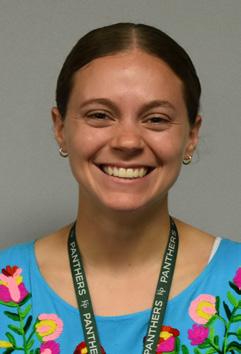
Q: How would you describe Gen-Z?
A: “I think Gen-Z is very funny and sarcastic. They don’t take anything too seriously, is how I would describe it. A little cringe at times, but funny.”
Q: What do you think are some misconceptions some may have about Gen-Z?
A: “Maybe that they don’t work hard. I think plenty of Gen-Z do work hard, I think it’s just there’s different challenges today than there used to be. I think maybe another misconception is that every Gen-Z is addicted to their social media or their phone. Which I think is true for some, but not everybody. I know lots of kids who actually have
better screen time than I do.”
Q: How has your impression changed about Gen-Z since you started teaching?
A: “I kind of get the younger side, so the humor has changed a little bit. I understand now a little bit better from teaching, because I hear them talk and I hear the slang in context. It’s fun to teach Gen-Z, because they’re funny and they’ll joke with you and that’s fun.”
Q: What do you hope becomes Gen-Z’s ultimate label or the impression left by them?
A: “Hopefully what will be learned from them is that they can have fun in any circumstance and they can make the best of any circumstance. I think that’s what they do. They joke around in the hard situations to make it better. I feel like Gen-Z is also very welcoming with one another.”
Q: What are two of your favorite things Gen-Z has brought to society?
A: “I’m glad baggy jeans are back. That’s way more comfortable. I feel like they changed the music industry. Different types of music are becoming more popular now. Just like TikTok sounds and Instagram Reels sounds can make different music bigger, which I appreciate because I like learning and listening to new music.”
- By Sydney Ortiz

“Y2K outfits. The outfits look cool. I wish Instagram boomerangs would come, but like the ones with action not just a face.”
Shleby Roos, 9
“Low rise jeans because it suits me better and great for concerts. I wish the creative TikTok dances came back because they are all the same now and boring.”
Molly McCall, 10
“I kind of miss fidget spinners. I never had one when they were still considered cool. It was nice just to have something to do with my hands when I was bored.”
Branden Crum, 12
“I would say the music, because old music is so much better than all the new ones. And the low-rise Jeans. I like the music and the jeans too, but sometimes some girl take the ‘lowrise” too serious.’
Elina Ratke, 11
“I think cartoons are something we slowly stopped watching. But then we’ve looped back around to them because they give us a sense of nostalgia. I’m glad they’ve come back because there’s so many cartoons that I’ve forgotten about and get to rewatch with the same interest I had back then because I don’t remember what happened next.”
Isabella Lane, 10

With the Class of 2029 is the last year of year, Gen Alpha will bring their own personalities the mix. For now,
Back in the day,
“[Snow White] was definitely one of my favorites because princesses is something that I share with my sister, a lot of Disney stuff. I became closer with my sister through that kind of stuff.”
Viviana Diaz-Jones, 11 “I mean, I’ve always been a Disney kid. I think it was just like one of the newer movies that came out, which made me like it.”
Sophia DeBurra, 12




2029 in the high school now, it all Gen-Z high schoolers. Next will infiltrate the hallways and personalities and characters to it’s time to appreciate Gen-Z.
we loved...


“Frozen was my favorite movie at the time because I was like four or five when it came out and I think it was everyone’s favorite movie at the time, every single little girl.”
Madison Moffit, 11

“Me and my brother would watch [Jake and the Neverland Pirates] every day after elementary school.”
Hudson Miller, 10



“When I was a bit younger, I used to collect snowglobes. Collecting these would be very special to me because, everytime I or my family members would go on a trip they would get me a snowglobe,and when I went on trips I would also choose one for myself.”
Jazmin Camarena, 10
“My Transformers collection. It started with the Rescue Bot 1-step changers which slowly evolved into the more advanced figures. My father started me on this path and its his fault it evolved into an obsession.”
Joshua Harris, 9
“A collection I had growing up was dolls and slime. I don’t recall how my collection of dolls started but I remember constantly getting dolls gifted to me. My collection of slime started through the internet. It became very popular and I begged my mom to make some for the first time and after that I couldn’t stop.”
Terrellyn Owens, 11
“My older sister used to collect a lot of Barbie dolls and would let me and my other sister play with them, before we started our own collections.”
Samantha Fajardo, 10
“I collected TY’s, they’re little stuffed animals with name tags. I started collecting them at the airport then everytime I went to a store, now I gave them all away.”
Kalia Powledge, 11


Senior
Tia Thompson is bringing back the Heely fun. She wore them in elementary school until they were banned.
Q: When did you first get your Heelys? Can you describe that moment?
A: “I got my first Heelys when I was in elementary school, probably fourth grade and I fell in love. Especially as a person who loves rollerblading and skateboarding, I thought wheels built in my shoes were the coolest thing ever until they were banned at my elementary.”
Q: Do you plan to buy anymore in the future?
A: “Absolutely. I don’t care how old I am, I’ll always be rocking Heelys.”
Q: If you could design your own wheels what would it look like?
A: “This is an absolute nightmare, but ones that leave a trail of glitter when I skate.”
Q: What has been your least favorite part about owning Heelys?
A: “Least favorite is that if you’re not using the wheels, it’s kinda hard to walk in them but you get used to it.”
- By Cameron Minatrea
By Caleb Kazeem Staff Writer
Sophomore Jon Pavlatos has played football since he was 5 years old for one reason – to be like his father. His father Matt Pavlatos wore the number 51 in high school as a defensive player, which led Jon to wear 15.
“He inspired me to play, so I just try to follow in his footsteps,” said Jon Pavlatos.
As Pavlatos grew older, his father realized he was more of an offensive player, leading his son to play quarterback. Matt expects his son to be able to take hits and run the ball well.
“He expects me to do it all,” Jon Pavlatos said. “That’s the standard I’m held to.”
Pavlatos got his first start on an Atascocita flag football team.
“ He has loved football since he was able to walk and pick one up,” Judy Pavlatos said. “ His big helmet, his little body and this giant helmet. He looked like a little bobblehead running around and it was just the funniest thing.”
time during 7-on-7 and has seen great improvement from the sophomore.
“He takes charge in the huddle,” Gerbasich said. “He tells us what to do, and he is very respectful in the way he does it.”
Last year, varsity was led by senior Aaron Gilliam, who transferred to Kingwood Park from Porter and led the district with 1,178 passing yards. The Panthers finished 4-6 overall and missed the playoffs with a fifth-place district finish.
Senior tight end and team captain Luke Elliott understands that Pavlatos is younger than most of the varsity starters, but Elliott has set high expectations for him.
“He’s a sophomore working with seniors, but he knows he has to be a leader on and off the field,” Elliott said.
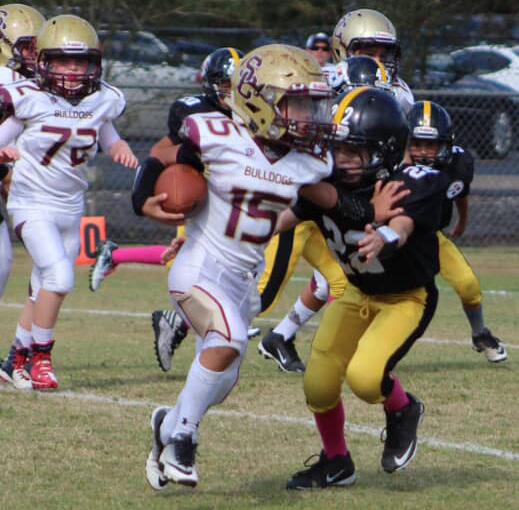
Judy Pavlatos says throughout Jon’s life he has been physically stronger and a great leader. More recently, she has seen him grow mentally.
“ He is a different kind of discipline when he’s out in that field,” Judy Pavlatos said. “His confidence is on a different level when he puts that helmet and put those pads on.”
Last year, Jon Pavlatos was the starting quarterback for the JV “A” Black football team. He recorded 36 total touchdowns and led the team to a successful 9-1 record. However, Pavlatos understands that on varsity kids are bigger and faster and it won’t be as easy.
“Small things matter,” Pavlatos said. “When you have a chance to go big, if you don’t hit on it, you won’t get that chance again like on JV.”
Senior wide receiver Bryce Gerbasich has been working with Pavlatos since the spring
This season, Pavlatos passed for over 1,000 yards and recorded 10 passing touchdowns. He has also rushed for an additional five touchdowns and led the Panthers to 3-1 record.
Offensive coordinator and quarterback coach Scott Elliott said Pavlatos has picked up the playbook quickly and that it fits Pavlatos’s play style and athleticism.
Even with a few changes from the spring, Pavlatos manages to keep up with the playbook and is learning the offense more and more as time goes on.
“He has a photographic memory,” Elliott said. “He may make a mistake on a Monday, but by Tuesday he already has fixed it.”
Coach Elliott is focused on helping develop Pavlatos’s game throughout the season so the team can be successful.
“I’m expecting him to lead us to a district championship,” Elliott said. “I want him to get better every practice, so as we are getting ready for playoffs, he’s not just a sophomore quarterback.”
Jon Pavlatos wants the game thing. He has one goal set for the team.
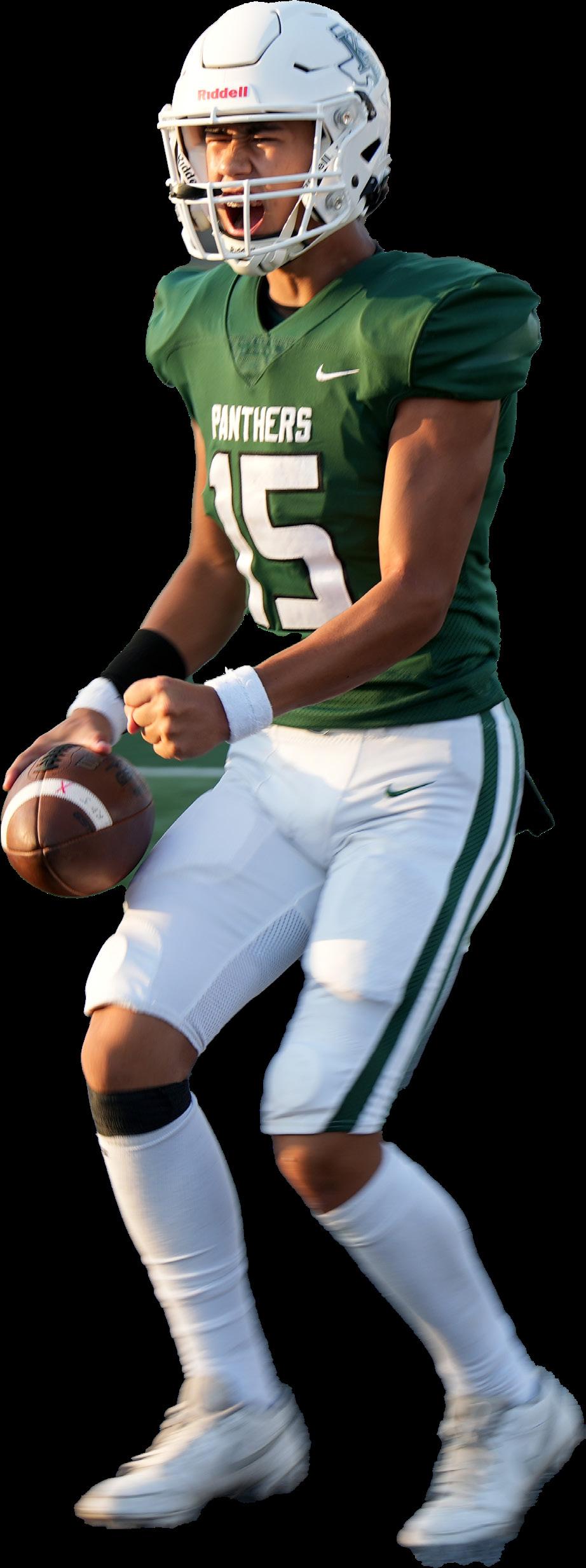
“I’ve already set my mind to it,” Pavlatos said. “We are going to the playoffs this year.”

By Rayden DeSouza Staff Writer
For the first time in Lady Panthers’ swim history, they have four NISCA All-American athletes.
The qualifying race was the 200 freestyle relay at the 2025 UIL 5A State Swimming Championships with a time of 1:36.50, where they placed second. The team consisted of 2025 graduate Cecelia Sullivan, senior Marisa Stone, junior Marie Wakefield and senior Elena Amos. They also broke the school record in the event. Each girl swam a personal best for their split in the relay.
“They all swam faster than they’ve ever swam in a relay,” coach John Dissinger said. “They really put in a great performance.”
After the race, Coach Dissinger told the athletes they were in consideration for All America. The NISCA All America competition consists of the 100 fastest times in the country. There are two qualify-
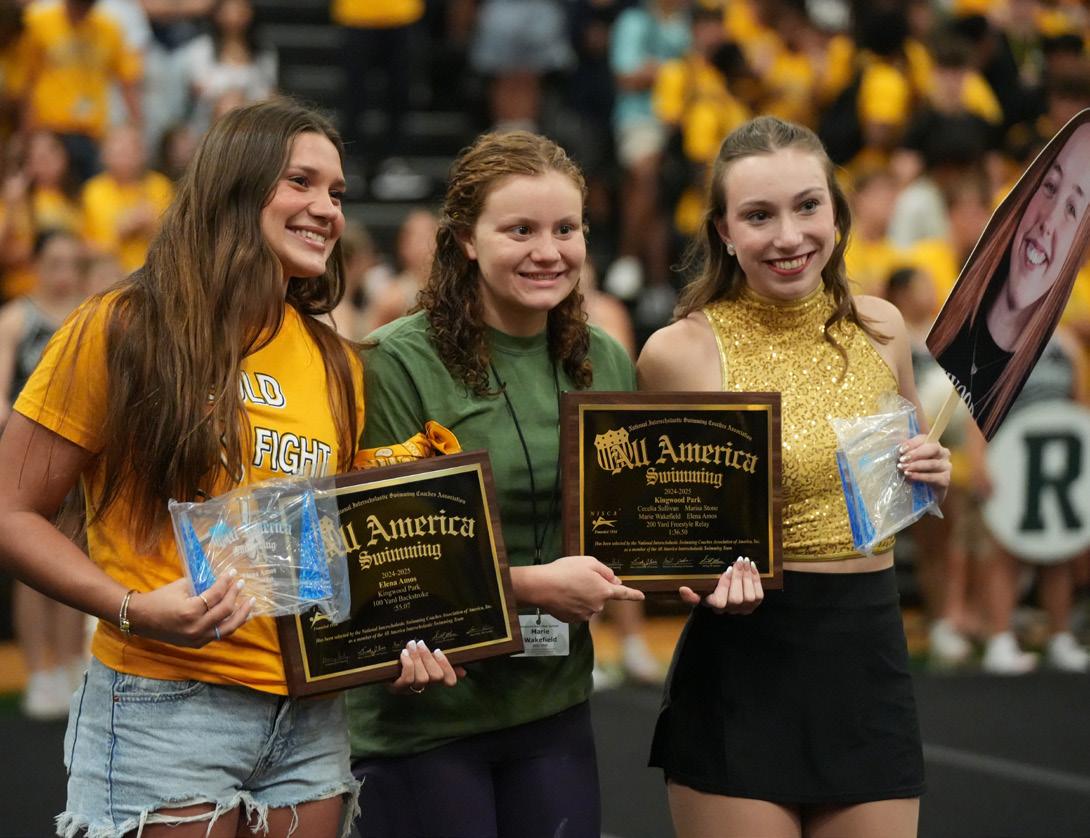
At the Go Gold pep rally on Sept. 12, senior Elena Amos, junior Marie Wakefield and senior Marisa Stone hold up the All American Swimming plaques they were awarded. Last year, at the State swim meet, the 200 freestyle relay team placed second and recorded the All American time. Photo by Sydney Ortiz.
ing times – reaching the faster one is an automatic All-American qualifying swim. The other is the consideration time, which means if there are less than 100 automatic qualifiers and the consideration time is still in the top 100, there’s a possibility they could be AllAmerican.
“I thought about it every once in a while,” Stone said. “I just thought it would be like super cool if it did

happen.”
The team had to wait for about six months before they could find out if they were All-Americans. They eventually found out they placed 98th in the country.
“I think I was baking my grandma’s birthday cake,” Stone said. “And my dad, he texted me the list and was like, ‘Congratulations Marisa.’ It was the same day that it came out because it was before Coach even texted us. My dad was apparently checking often.”
The swimmers received an official certificate in the mail and assumed that was the end of it. However, at the school’s Go Gold pep rally on Sept. 12, they were honored in front of the entire school and given a plaque and letterman patch.
“I’m not very good at surprises, so I was glad I pulled it off,” Dissinger said. “It was very exciting because we knew that their time would have made it the year before. So when it was official, we celebrated.”


By Tricia Darcy Editor-in-Chief
Cheerleading and playing football revolves around energy. Creating the traditional “Friday Night Lights” atmosphere that has become a large part of the Texas high school culture revolves around energy.
Every week, the atmosphere that is created at football games is fueled by the performance of football players, cheerleaders and dancers.
“It all revolves around energy,” said senior Cooper Robinson, who has been on the varsity football team and cheer team for two years. “If you don’t have energy in football, you’re going to lose. If you don’t have energy in cheer [competitions], you’re definitely going to lose. I feel like it’s just a big part of both sports.”
With many similarities between the two sports, many football players and other athletes have found a new interest in cheerleading. During tryouts for the 20252026 school year, the increase in interest for boy cheerleaders was most notable.
The popularity of the coed cheer team grew significantly after the team won the 2025 UIL Spirit Coed State Championship for the first time in program history.
“It was a lot easier to get more guys this year,” cheer coach Brittni Sharp said. “It helps too because once you already have guys that are bought in and they’re encouraging the other guys, it just makes everything so easy.”
Before the success of the coed cheer team, Sharp knew she wanted to bring back something from her own high school experience. Sharp, who went to Atascosita High School, talked with assistant coach Natalie Johnson, who previously coached a coed team, about implementing the idea.
In April 2024, Sharp created the “Bring a guy to practice” event to kickoff the new idea before the 2024-2025 school year. Seniors Alec Krippel, Carson Kee, Mark Gonzalez and Robinson were
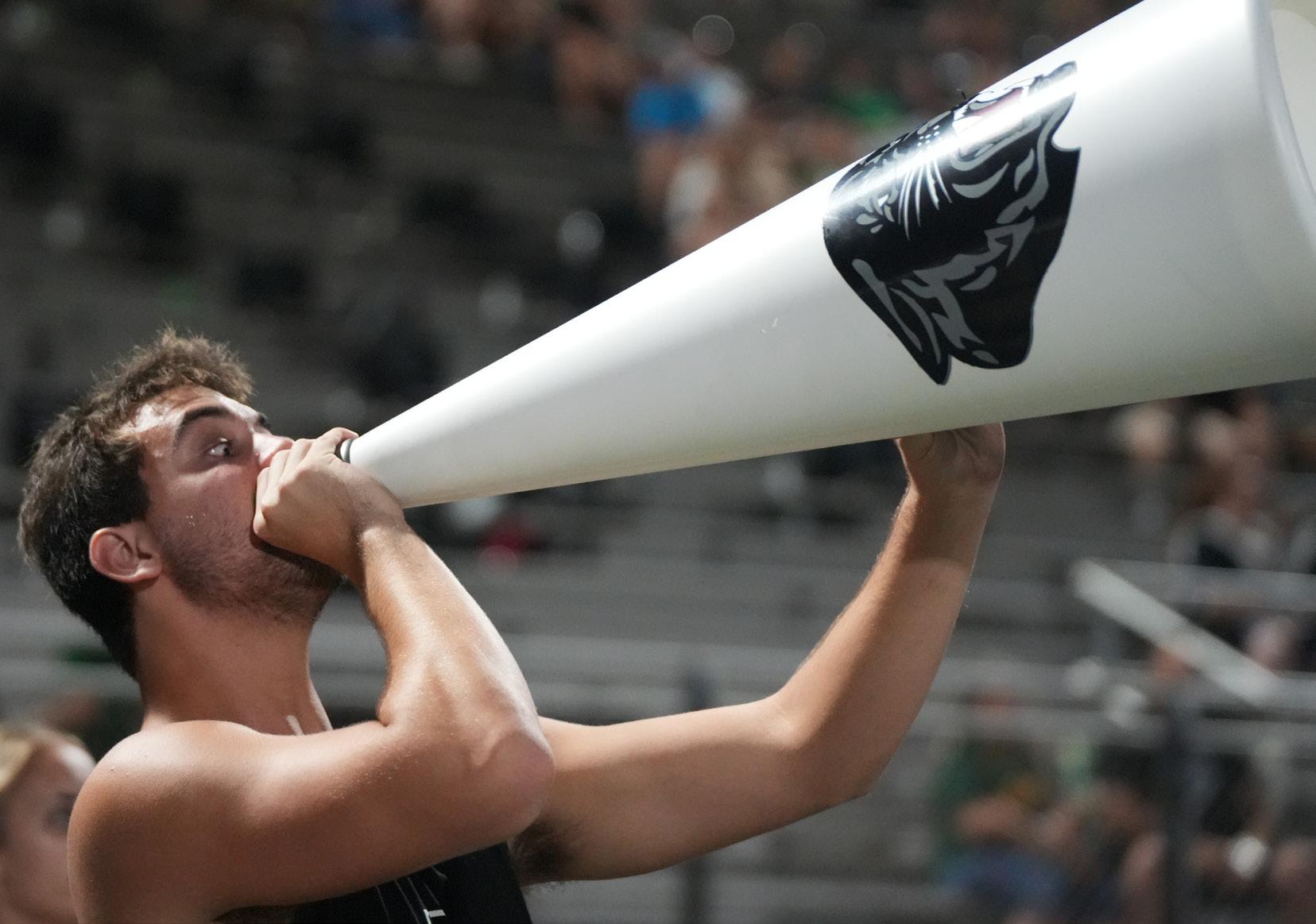

among those who participated in the event and are now helping teach stunts to newer members.
“This year, what’s cool is the
veterans are able to help my new guys,” Sharp said. “My new guys, I noticed, are getting more advanced and improving way
quicker than last year’s boys, just because last year’s boys are able to help them.”
Last year, several of the boys found that going to private coaches and cheer camps throughout the season helped them get better in the long run. Now, the second year members are helping Sharp teach stunts to new members.
Krippel, who is a second year member, said he quickly found his place on the team.
“It really just reminded me of home and the cheerleaders were super welcoming,” Krippel said. “It took a bit at first for us to get acquainted with all of them and for us to really get to know all of them and be close with them. But after that it was great.”
Athletes who do other sports are able to be in both class periods, because the state of Texas recognizes upper level cheer classes as Dance Specialty courses, which count as a fine arts credit while first-year cheerleading courses are recognized as an athletic credit.
Sharp said she works with the athletes, especially when their other sports are in season, to make sure they are able to have enough practice with the team.
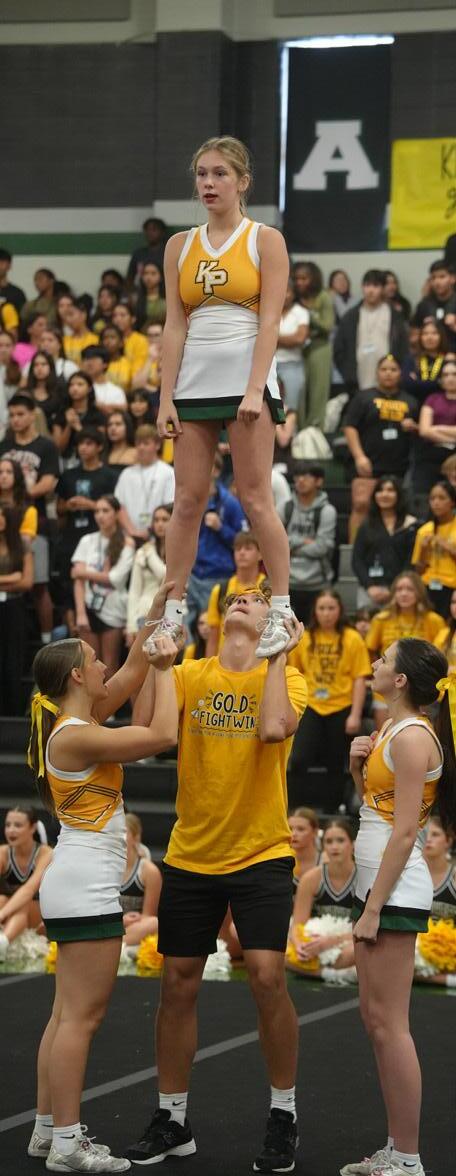
With 13 seniors leading the way, the varsity tennis team went undefeated in the fall season. It was the team's fourth consecutive undefeated District Championship.
Coach John Macapaz scheduled a pre-season against mostly 6A schools to prepare for districts.
“We go into these matches saying you gotta show up, we gotta make sure that we're prepared,” Macapaz said.
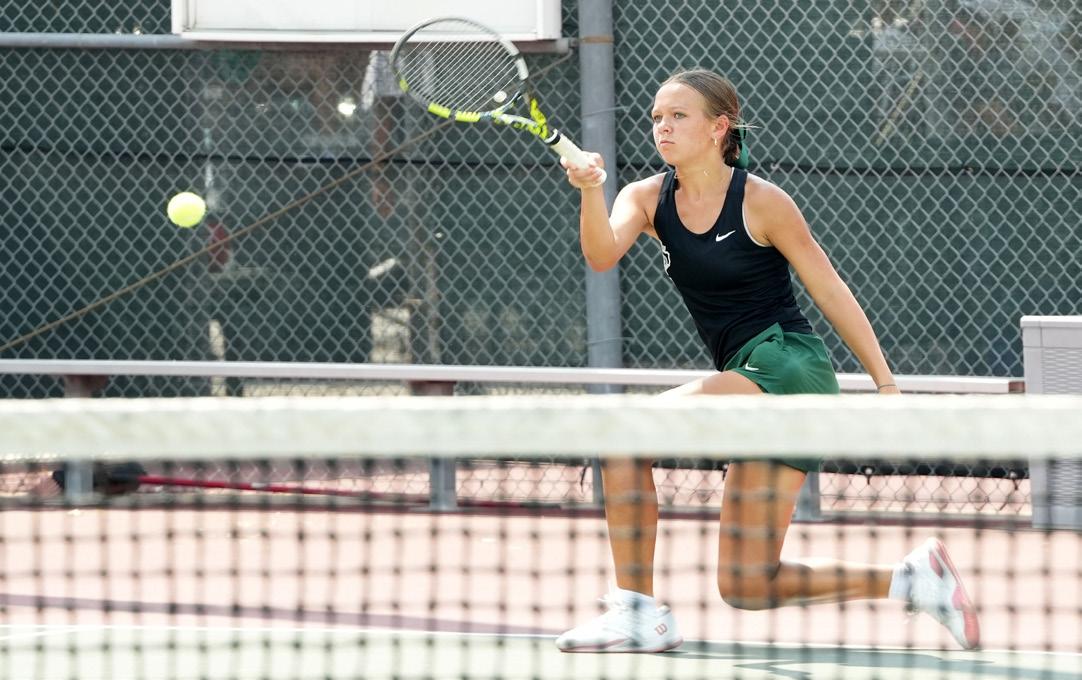
Q: What has been the best part about becoming a captain?
A: “I really like planning things, like team dinners. This year for the first time we did the Gold Fight Win. That was really fun.”
Q: How would you describe the season?
A: “I feel like we’ve had a really good season and I feel like personally this is the best season I’ve ever had. It’s been awesome.”
Q: What has been the best part about becoming a captain?
A: “Being able to lead a team. We’ve been successful in the past few years so it’s good to be able to help go for four in a row.”
Q: How would you describe the season so far?
A: “It’s been up and down. We’re undefeated in district play, but it’s been harder with other opponents.”
“Coach Sharp caters to football because she knows you have to learn more and stuff,” junior Kaycee Russell said. “Basically she helps us by practicing more in the period.”
With less of a stigma surrounding boy cheerleaders, the cheer team hopes to find more successes throughout their competition season. But without having the intense competitions near, the focus has been towards bringing the energy to football games and pep rallies.
The energy that is needed in competitions and in football games has helped elevate the performances on the sidelines.
“Me and Carson have a blast on the sidelines,” Krippel said. “We love running around with the flags. We love yelling into the [megaphones]. We love watching the game, especially when a cool big play happens, the atmosphere is great.”
Q: Do you prefer playing singles or doubles?
A: “I prefer singles more because I’m crazy. I enjoy running around everywhere for stuff.”
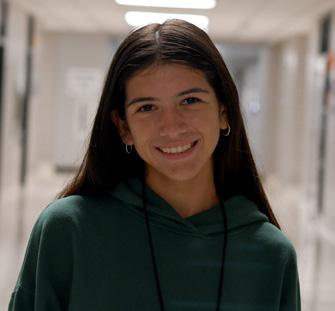
Q: What is your favorite brand of tennis racket? A: “Babolat.”
Q: What is your favorite brand of shoes for tennis?
A: “I like Nikes. Nikes are my favorite.”
Q: What is the best part of playing fall tennis?
A: “The bus rides and just how much time I get to spend with my team.”
Q: What is your favorite practice activity?
A: “Cardio running. Whenever you miss or make a mistake, you have to run to the fence and back. I think it’s fun because I enjoy the running.”
Q: Favorite pregame meal?
A: “I love eating fruit before the game. I love grapes, grapes are my favorite fruit.”
- By Cameron Minatrea
Q: Do you prefer playing singles or doubles?
A: “I think singles because I’m by myself and I don’t have to worry about a doubles partner or making a mistake. I like having more open space.”
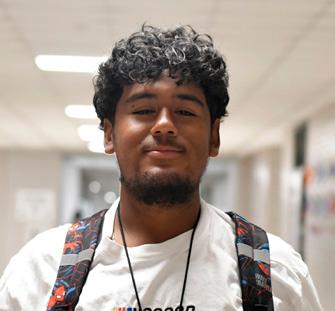
Q: What is your favorite brand of tennis racket?
A: “Right now, Yonex.”
Q: What is your favorite brand of tennis shoes?
A: “Adidas.”
Q: What is the best part of playing fall tennis?
A: “Everyone being together and hyping each other up. The whole team is there and it’s a lot better.”
Q: What’s your favorite practice activity?
A: “I think serving warmups or serving activities, because I see it as my weapon. I love practicing it.”
Q: Best pre-game meal? A: “Chicken and rice.”
Q: Do you prefer fall or spring ball?
A: “Spring. I get to choose what I want to play. You get to miss school and go to a bunch of places, so it’s fun.”
- By Cameron Minatrea
Senior Jennings Barndt returns from broken ankle with big goals.
By Cameron Minatrea Sports Editor
Resilience is defined as being able to sustain shock without permanent deformation or rupture. Senior Jennings Barndt is resilient, because no matter the injuries or setbacks he has sustained, he only saw them as temporary complications and ran right through them.
But Barndt is used to running by now. He has competed in long distance races since he was in fifth grade, winning a small trophy for most miles run in his grade. He had the drive, he said, he just needed a sport to use it on.
“I wanted to be in athletics and you either did football or cross country. I was a pretty scrawny kid,” Barndt said. “I couldn’t really do football, so I just decided to run.”
This ultimately was the best decision for him, as he participated in cross country all the way into high school. He had successful freshman and sophomore campaigns, so his goals were high for his junior year.
During one of the midseason meets for the team, however, Barndt unexpectedly stepped on a tree branch and injured his ankle. At first he believed that it was only a sprain, but he came to realize it was much worse.
“I could definitely tell there was something seriously wrong,” Barndt said. “Usually when you twist your ankle, it’s a sharp pain. But this one, it was a different kind of pain. With each and every step, I could feel it, even when my foot was off the ground.”
The race was still going, and Barndt knew he couldn’t stop no matter the pain.
“I mean anyone in that situation, the first thought in their mind would be that they couldn’t finish
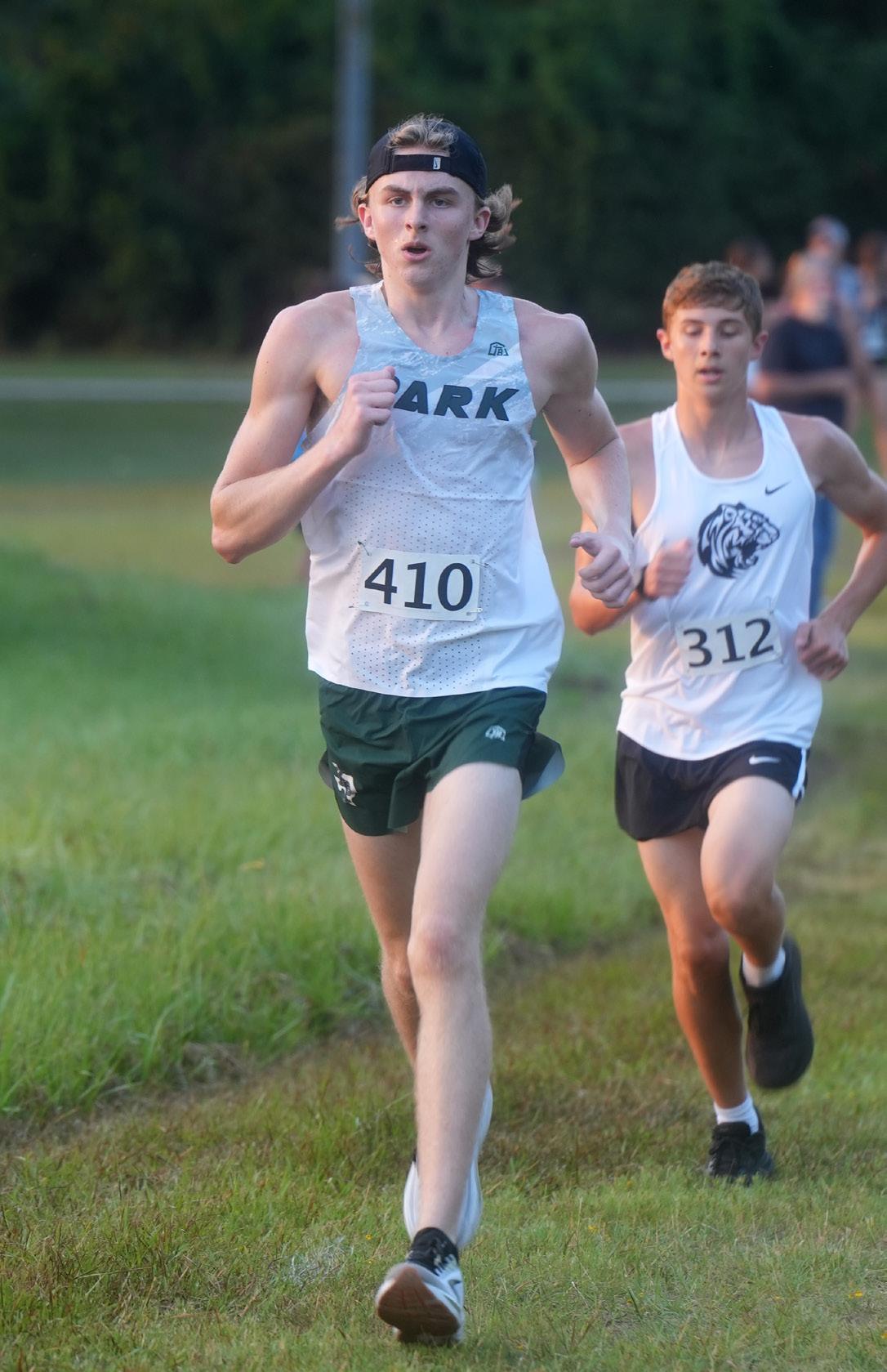
the race,” Barndt said. “But I just heard this voice in the back of my head saying, ‘Keep going. You’re halfway there.’”
No matter how much he wanted to stop, his body pushed him to the finish line, getting him a fourth place finish. Although Barndt collapsed as soon as he made it to the end, his teammates were there to support him.
“I fell to the ground and I needed people to carry me to the tent,” Barndt said. “They could tell I was injured. They could see it in my face. I could see it in my form, but they cheered me on all the way to
injury to set him back at all, and he used his resiliency to fuel him for the current season of cross country.
“Coming into last year, Jennings was one of our best runners,” coach James Higham said. “For him to go down with an injury late in the season, it was really tough for the team. But I’m excited. He’s one of our best guys. One of our leaders. It’s a blessing to have him back.”
Barndt has a couple of goals for his senior season. Not only is he hoping to make up for his missed time by helping his team make it to State, but he aims to step into a leadership role for his teammates.
Along with the other underclassmen, one person Barndt wants to most inspire is his brother –sophomore Bo Barndt. Jennings hopes that he can assist Bo as not only a brother but a teammate. Bo hopes to not only compete to beat his brother, but to compete to make it to state.
“He’s one of the oldest and most wise out of all the runners,” Bo said. “It’s also kinda competitive. We’ve been going after each other, and it’s been a way for us to push ourselves.”
Barndt has gone to new measures to prevent future injuries, focusing especially on stretching and warmups before practices and meets. He expects it will help keep him on track this season.
the finish line.”
The following months, however, he was the one cheering his teammates on.
He was out for the rest of the season due to a broken ankle, leaving him excluded from the district and regional meets. He was devastated.
“I was seeing all these improvements and they all got pushed back,” Barndt said. “I still got to go to region and cheer them on in my boot. I still got to be a part of the team, which was something I was worried I’d miss out on.”
Barndt didn’t allow for the
Whether it be a tree branch or a medical cast, Barndt’s resilient nature has kept him on his feet. Barndt hopes he can maintain a positive mindset and prove to not only himself, but others around him that there is always a finish line you can cross, you just have to push yourself to it.
“The only way for an injury to heal is with time,” Barndt said. “You can spend all that time moping around, or you can take a positive approach and continue to work hard.”


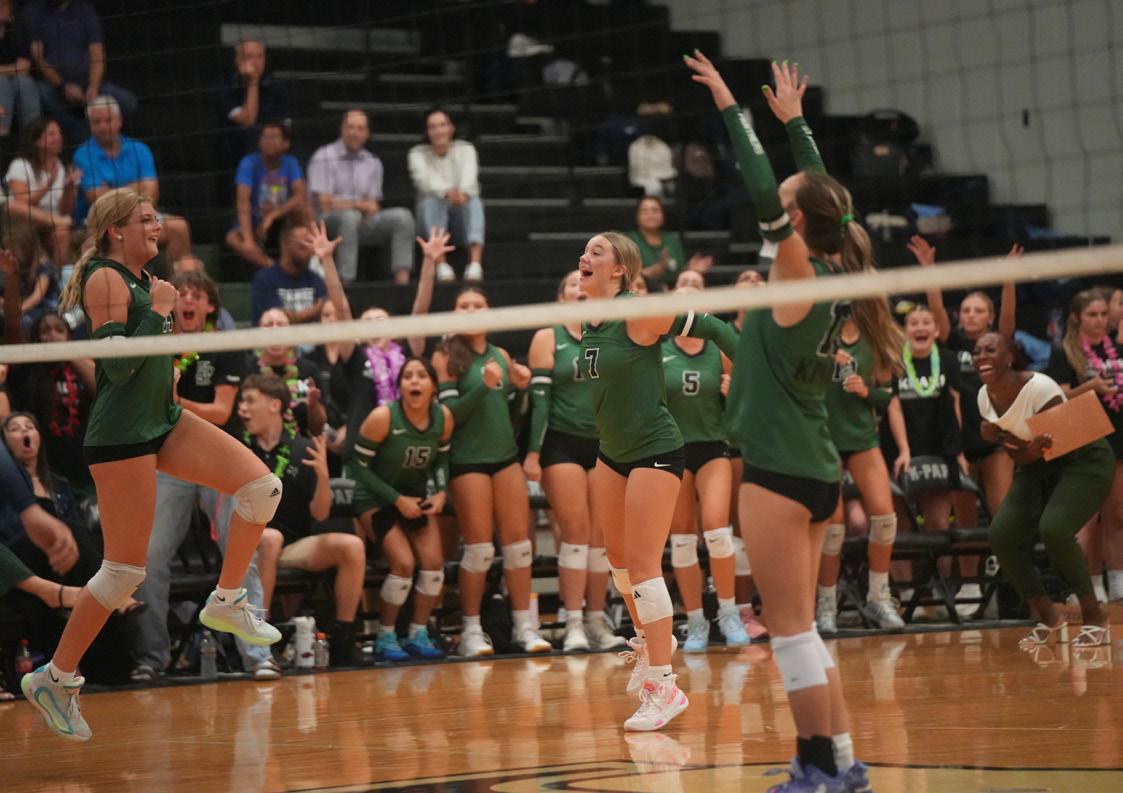
By Danielle Nalley Online Editor
For the first time in eight years, Kingwood Park topped Kingwood High School on the volleyball court. The Panthers won, 3-1, on Aug. 29 at home.
After winning the gold bracket in a tournament a week before hosting Kingwood, the Panthers said they were feeling confident.
“I had full confidence we were winning, so I don’t think I was nervous,” senior Olivia Parker said.
After volleyball camp in the summer and conditioning two weeks before school, the team was expecting to win the annual matchup against the Mustangs.
Going into the game coach Nakia Taylor made sure the girls knew this was just for fun and to give their all.
“I wasn’t really preparing for the Kingwood game, but we did go in with the mindset of we have nothing to lose,” Taylor said.
The seniors said that the team created closer bonds this year, which has created chemistry and good communication on the court.
With a change in coaching, a new culture was implemented into the team, not just preparing
players for volleyball but for the real world.
“I’m coaching them to be individuals, human beings outside of volleyball,” Taylor said.
The Kingwood game was highly anticipated by students, and the stands reflected that with a good crowd, chants and much yelling. The energy on and off the court was noticeable.
After a rough third set that led to Kingwood getting on the board, senior Kaely Evans said she was determined to not let losing the point bring the energy down. The student section, which was led by senior Van Cradic, remained active in the fourth set, helping lift the team to the win.
“In the fourth set, when there was one kill that was close to the 10 foot line, everyone started shouting, ‘M.V.P.,’” Evans said. “It pumped me up a little bit more.”
This energy caused the fourth set to be game winning and it led to a momentous win for the team. They have been chasing that feeling ever since.
“We brought that game win into our next tournament and the girls did well," Taylor said. "It was a tougher tournament against a lot tougher teams. They were able to carry it on.”
The new Texas House Bill 1481 bans the use of phones by students from the time they enter the school until the last bell at 2:55 pm, in an effort to reduce distractions during class. However, this ban is statewide — instead of being left up to individual districts — making it overly broad, excessive and unfair in certain situations, such as lunchtime, where phones aren’t affecting learning. It should be at the discretion of teachers who understand their students far better than distant lawmakers.
The bill ensures “the district or school complies with a written policy prohibiting a student from using a personal communication device (PCD) while on school property during the school day.” It was signed into law by current Texas Governor, Greg Abbott. The bill passed in the House of Representatives with a vote of 128 in favor and 17 against and passed in the Senate with a vote of 31 in favor and 0 against.
The bill intended to reverse the negative effects that phones and other devices have had on children.
By Shawn Chaney

As stated in the text, the bill “aims to mitigate the negative effects of a student’s use of personal communication devices … to create a more focused, engaging, and safe learning environment for students.”
If the bill was intended to combat the negative effects of phones, why not just outlaw students from having their cell phones at home?
Lawmakers are getting as close as they can to banning phones at home by banning phones from when you walk into school. For some students, that is as early as 6:45 a.m. This includes the four lunches and flex hour — two very non-academic times where distractions are not an issue. Laptops are among the list of things included under the PCD umbrella. This affects many students who relied on their own laptops from home to do online assignments
October 2025
Volume 12, Issue 1 Kingwood, Texas 77339
EDITORS
Tricia Darcy & Sydey Ortiz, editors-in-chief Danielle Nalley, online editor Cameron Minatrea, sports editor Paisley Thomas, opinion editor
STAFF WRITERS, PHOTOGRAPHERS & SPECIAL CONTRIBUTORS
Muhammad Adnan, Chase Canlas, Shawn Chaney, Jack Coffey, Charlie Crass, Rayden DeSouza, Jacob Dinh, Eleanor Durand, Kalia Gaeta, Joshua Harris, Rocco Huerta, Caleb Kazeem, Marien Martinez, Jackson Matlock, Michael McElmurray, Alex Pozzi, Amita Ramcharan, Pilar Retamales, Chloe Sales, Fabiain Smith, Marie Wakefield. Adviser: Megan Ortiz
Cover: Photos on the cover are of students (Chloe McKee, Miguel Ardon, Alex Pozzi, Ashley Montelongo) who carry cameras in their bags this year to record what happens. Photos by Tricia Darcy.
instead of using the school-provided Chromebooks. These students might prefer to use their own laptops since the Chromebooks aren’t regularly cleaned, but more so because of the low-quality Chromebooks and other school-provided devices.
For the last couple of years, math teachers have had an effective system for dealing with students’ phones being a distraction. Most took up every student’s phone as they walked into the classroom and put them into a wooden cell phone holder, which remained at the front of the classroom. Phones could only be retrieved after students had finished all their work for the class, including any unfinished assignments from previous days. Occasionally, phones were held until all students in the class had finished important assignments, such as tests and district checkpoints. This system offered an incentive for students to finish their work and participate in class, especially for certain students who weren’t motivated by grades. It was a powerful motivator.
Some students who struggle with
neurological problems like ADHD, dyslexia or autism have issues with staying focused on their work during class. Sometimes this is caused by all of the background noise that’s in a typical classroom full of teenagers, the buzz of fluorescent lights overhead, or by things completely unrelated to school, going on in the back of their mind. Listening to music on their headphones is sometimes the only way that they can tune out all of the distractions around them and finally finish their work.
Texas’s phone ban might have had good intentions behind it, but it ultimately missed its mark because it did not take into account how this affects all the students and even staff. Instead, the lawmakers thought that punishing everyone equally would inspire students who couldn’t care less about school to suddenly be jumping for joy and be ready to learn every time they walk into class. Legally restricting students even more with what they can and can’t do for more than eight hours a day is certainly not how motivation is built.
KP Media is the official student-produced media of news and information published/produced by KP Media students. KP Media has been established as designated public forums for student editors to inform and educate their readers as well as for the discussion of issues of concern to their audience. It will not be reviewed or restrained by school officials prior to publication or distribution. Advisers may – and should –coach and discuss content during the writing process.
Because school officials do not engage in prior review, and the content of KP Media is determined by and reflects only the views of the student staff and not school officials or the school itself, its student editorial board and responsible student staff members assume complete legal and financial liability for the content of the publication.
The media will serve the best interest of the students and faculty of Kingwood Park High School, keeping itself free from any commercial obligations distracting from this purpose; this is defined by the media itself.
All writing in the media, other than letters to the editor in the newsmagazine, will be written by students of the journalism program and will not be accepted otherwise.
The media will specialize in and emphasize on informing their readers of school news and unique students of the Kingwood Park High School community.
The media will cover community, state, national, and international news if it is directly relevant to the school community, and includes local angles.
The media will strive to provide coverage to all school organizations and functions.
Any decisions affecting the publications on all levels will be made by the editorial board, the adviser is allowed to give legal advice and his/her opinion, but the final decision rests in the hands of the editorial board.
Only the editorial board may prevent material it judges to be in violation of the media editorial policy, from being printed.
Letters to editor will be printed in the opinion section of the newspaper or on the website. Letters to editor should not exceed 300 words, must be signed and must include writer’s address and phone number for verification. Letters to the editor will be verified by a member of the editorial board to determine the authenticity of the writer.
The school newspaper will be distributed free of charge to all students every 6-8 weeks. The paper is completely financed by advertising revenues and fundraising. The money raised is used to pay for the school media printing costs, supplies and other media expenses.
See the entire staff editorial policy at KPTimes.com
As the cast of “In the Heights” waved each of the flags mentioned in “Carnaval del Barrio,” the crowd cheered along for the flag that represented their culture. That scene is a moment I will never forget. As members of the cast held up the Mexican flag during the song, my sister and I proudly joined the raucous applause.
BY SYDNEY ORTIZ
By the end of the 2 ½-hour TUTS show at the Hobby Center, my cheeks were sore from smiling so much. As a proud Mexican-American, it makes a difference when I see people who look like me on stage celebrating and elevating Latino culture.
In today’s society, it has become normalized to demean Latinos. It is easy for me to forget to embrace my culture. Although I live near Houston, where 44% of the population are Latinos, my hometown suburb does not reflect those numbers. In Kingwood, there is one Latino person for every five people. However, when I was at “In the Heights” I was transported to a neighborhood full of people who looked like me. I had never been in a room with so many strangers where I felt at home.
I love all musical theater, but “In the Heights” was the first show with which I felt I could truly connect. I saw little parts of myself through each of the characters. As I watched Nina, I related to her internal struggle of trying not to disappoint her family. I felt connected to Usnavi, who felt like he couldn’t fully embrace his Latino culture because he wasn’t in the Dominican Republic.
Concerts. I know y’all saw Laufey x Benson Boone.
DWTS. Robert Erwin, I didn’t know you could dance like that…following in Bindi’s footsteps.
Extra credit. YES, an extra five points to round out my grade. Thank you, teachers!

As I watched, I remembered I wasn’t alone. These struggles I try to hide from my friends and family are experiences other people face. For most of my life, I believed I wasn’t Latino enough. Spanish wasn’t my first language, and my confidence speaking the language to family members is non-existent. I can understand Spanish, but only if spoken at snail’s pace. And to be honest, I won’t eat refried beans or corn tortillas.
When I had my Quinceañera, I realized I wasn’t fully separated from my culture. I love to listen to Spanish music, eat birria and celebrate our traditions. Also, I can speak Spanish even though my anxiety tells me otherwise. I love learning more about my culture through stories from my nino and nina, who
Help. It’s my whole FYP.
Haunted houses, painting pumpkins, and PUMPKIN SPICE? Heck, yes! Colorful Hair. Might have to go dye my hair right now!
emigrated from Jalisco, Mexico, in the late 1960s.
No matter how connected I feel to my culture in moments, I always have felt proud to be Latino. I love visiting my grandparents in Las Vegas, making tamales with my tias and cheering for the Mexican national soccer team with my dad.
Watching “In the Heights” didn’t make me proud to be Latino; it made me feel celebrated in a polarized country. It seems like all the news coverage on Latinos these days is negative. It is rare to find an article that portrays immigrants as humans and really dives into their personal story. In movies and TV shows, Latinos are portrayed as gang members, drug lords or uneducated. These stereotypes warp reality and encourage racism and
NOT? Hallway Hoco Proposals. It’s a flash of screaming, awkwardness and clapping. We never know the people anyway. Houston Sports. Texans... Astros...
shame.
When my sister introduced our family to “In the Heights” in 2017, it instantly became a safe haven, a place where my Latino experience was celebrated. I memorized the lyrics to “Carnaval del Barrio,” “Inutil” and “Breathe.” I sang them constantly in the house. I begged my mom to turn it on in the car. When the movie came out in 2021, I watched it five times in two weeks. I never expected a musical that 8-year-old me thought was fun would strengthen my connection with my Latino culture in 2025. Seeing it on stage, I beamed with pride. I held back tears as I cheered for the performers at the end of the show, overcome with emotions of how much I truly loved my family and my culture.
Please cool down. Away football games. Our student section has seen better days. Flu season. STAY AWAY FROM ME. I refuse to go through that trauma again. Jobs. Everyone is always working...
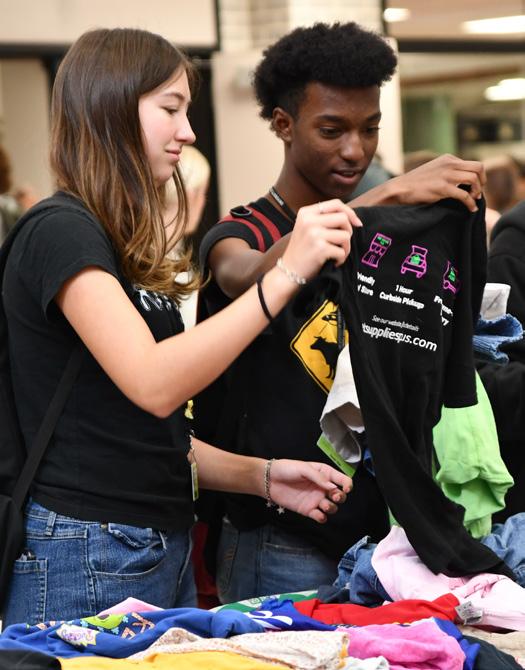
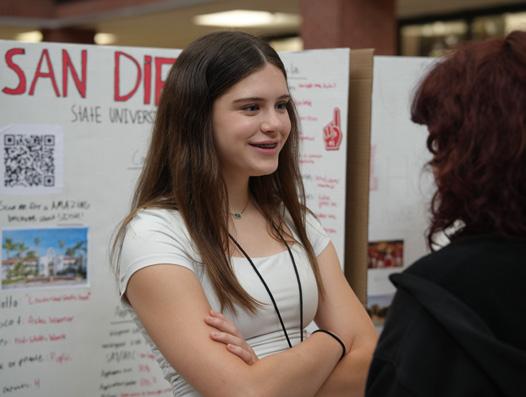
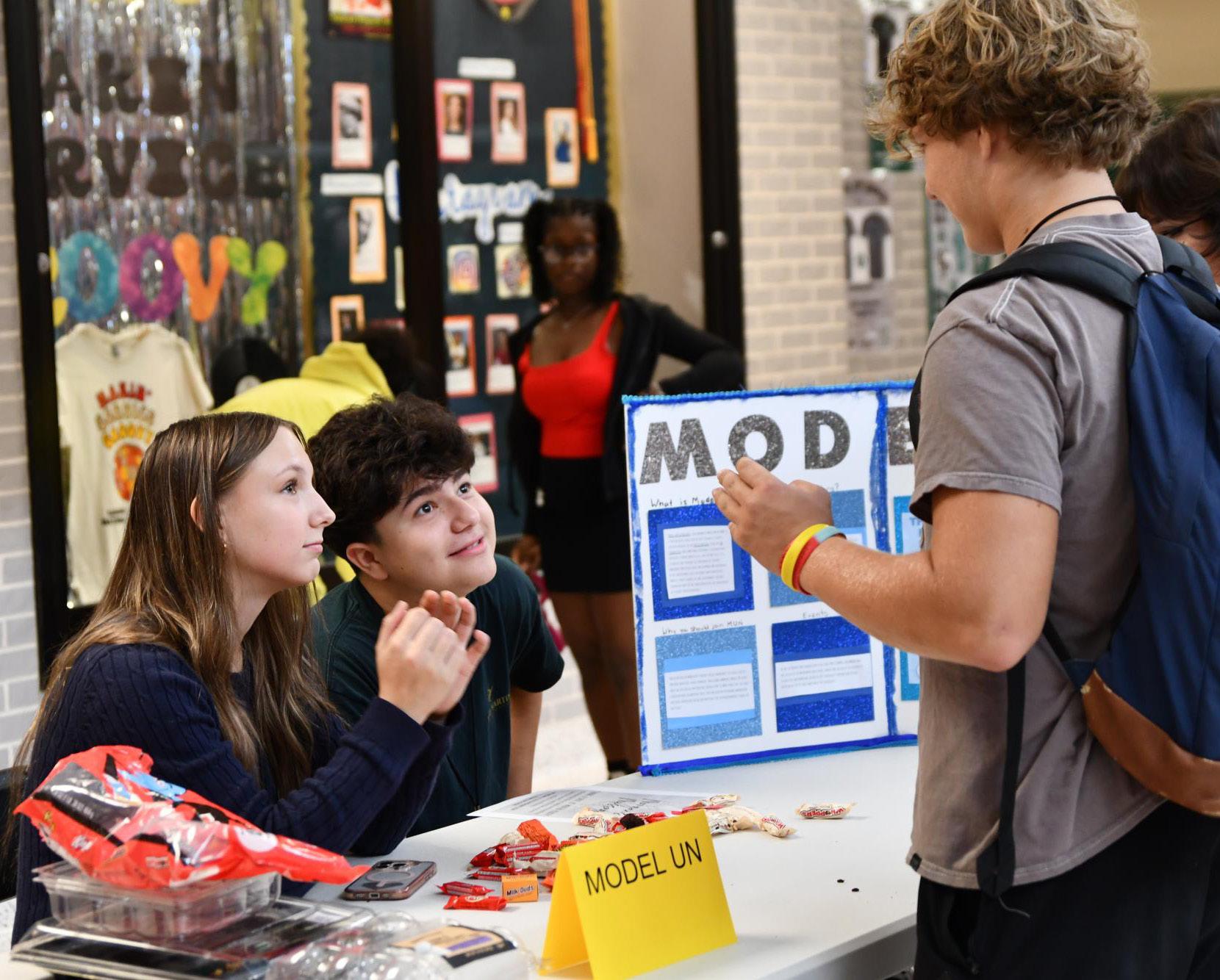
The attraction of attending Kingwood Park is that it is sold as a place where kids can do anything and everything they can handle. They are encouraged to be multi-sport athletes and active members of organizations. On rare free nights, they then show up and support their classmates in their activities.
As district’s only 5A high school with 1,800 students, “We are KPARK” is proudly shouted at sports events and pep rallies. But with Flex Hour being removed from the daily schedule, our strong culture is slowly dying. For a school that has always emphasized the importance of being active in high school, the tune is changing. Students are now being told they need to pick priorities and that doing everything is just not possible.
With Flex Hour, your home situation didn’t make a difference. You could catch the bus, pick up your little sibling from elementary school, attend your sports practice or make it to your 3:30 pm work shift all while being on top of your school work and being part of any clubs or organizations that interested you.
With clubs being held during the one-hour lunch break, students met up with classmates
who shared similar interests – whether it was Fashion Club or Chess Club or Asian-American Club. There were meeting times all throughout the week for kids to express themselves while meeting up with new friends and old friends.
Moving clubs to after school is eliminating so much of the population who can no longer feasibly attend the meetings. Finding a sponsor to volunteer to stay after school is also a challenge.
In addition, Flex Hour allowed students to take a mental break. Students got their energy out by walking laps through the hallways, escaping the confines of the small classrooms.
Athletes and band members arrive at school around 6:45 a.m. and leave at 5:30 pm. Ten hours non-stop with only a singular 30 minute break is just not suitable for students and their mental health.
Friendships were formed during the hour, and the lack of Flex Hour limits students’ abilities to meet new people and make new friends.
Flex provided a balance to students and it isn’t fair to force them to pick and choose what to make a priority, especially when that contradicts exactly what our school was built to encourage.

In one week, students spend seven and a half hours total with their fifth period classmates – the equivalent of a full day of school. The new four-lunch schedule used during the first nine weeks was completely new to teachers and students. Staff members share their fifth period experiences.
HMy teacher calls the 90-minute fifth period we have in lieu of Flex “the 80-year-long” class. The administration calls it “building communities.” My friends call it “so stupid.” And me? I call it “homework and study time,” though I am in the minority. Without Flex, my time for academics is stretched thin, so my 35 minutes are spent silently working on homework. Sometimes I mourn the loss of my social life, but to what end?
Most of my class plays large card games like BS or interactive ones like Jenga and Mafia when our lesson is completed. Our desks shoved together in a big block remind me of a family dinner table; with people arguing and laughing and gossiping. Once in a blue moon we’ll have the aforementioned community building, which usually consists of a slideshow and then people passing around a stuffed otter with their one word answer.
I don’t hate my fifth period, and I appreciate the free time, limited though it is.
Marie Wakefield, junior
In regards to my fifth period class, I greatly enjoy it. Of course, I would rather have flex back and the ability to join clubs again (which seems like it has gone extinct by now); but overall, I like my 5th period class. There may be some skewed data based on underlying factors such as, “Are there people you already know in the class?” “What is the teacher like?” “Is it an easy class?” that can affect someone’s view of the extended class period. I was lucky enough to not only have an easy and laidback class for my fifth hour, but I also know a lot of people in the class. The longer time spent means that we finish our work pretty early and the rest of the time we can talk or play games with each other. Flex Hour returning is the goal, but for now I do not mind my extended fifth period.
Jack Coffey, senior
aving a core class for a fifth period is not ideal, especially for straight-A students who get all of their work done at the beginning of class. My classroom is unreasonably close to freezing temperatures. I also sit at a table all by myself at the back of class while everyone else sits with their friends and chats the whole time. Because I have C lunch, this means I have to go back to my freezing classroom after 30 minutes of freedom. This also means I’m sitting in class where I’m cold, hungry, tired and lonely.
Shawn Chaney, sophomore
My 5th period either stresses me out or is super chill. I have a couple friends in that class, and some that I met in the class due to the fact that we are in the class for a very long time every single day. With the 30 minutes of advisory we have, I try to do my homework but with the amount of people that are in the class it gets very loud and overwhelming so half of the time I am not able to concentrate and I give up on my homework. The students that sit around me usually play cards and some days me and my friends will join them and it’s a pretty fun time. My 5th period is not my favorite but it could definitely be worse. I just wish it was a more chill class so I could get my homework done.
Marien Martinez, sophomore
Without flex, I’m stuck in 5th period for an extra 30 minutes. Normally, this would be a good thing: a quiet environment, time to work on homework and plenty of opportunities to build strong connections with others. But my class is quite the opposite. It’s full of loud and crazy kids who think they’re tough. They laugh so loud, I can hear them through my nice (wired) headphones. Usually, I use my valuable time to complete homework and then relax peacefully. However, I have no homework before 5th period, so I end up wasting my time playing games and watching YouTube shorts.
Chase Canlas, sophomore
Laughter. Random conversations. Tutoring.

I walk into 5th period – knowing it will last 90 minutes – with excitement. Eight classmates and I are constantly reminded we are our teacher’s smallest but loudest class. We actually spend so much time focused on our classwork, I’ve yet to actually have any homework in fifth period.
I was skeptical during the first week how it would be to spend 90 minutes every day in my smallest class. But the consistent 6-7 jokes somehow still make our mostly junior class burst into laughter every day. After we all finish our assignments, we hold informal class discussions about who would survive the Hunger Games, intriguing history lessons and which number from 0-9 is the most irrelevant.
I get excited each day to walk into class and am sad when one of my eight classmates is missing for the day.
Sydney Ortiz, junior
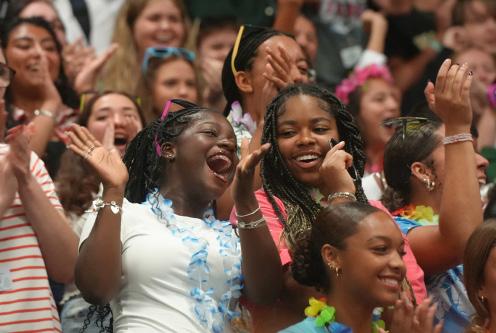
Ahighlight of the beginning of the school year is pep rallies where students get to celebrate their school spirit together. The Hawaiian-themed pep rally was on Aug. 29 and the Go Gold-themed pep rally was on Sep. 12.
